#mason thornhill
Text
Time for another new episode!
Script below the break.
Hello and welcome back to The Rewatch Rewind! My name is Jane, and this is the podcast where I count down my top 40 most frequently rewatched movies in a 20-year period. Today I will be discussing number 11 on my list: MGM’s 1959 spy thriller North by Northwest, directed by Alfred Hitchcock, written by Ernest Lehman, and starring Cary Grant, Eva Marie Saint, and James Mason.
New York advertising man Roger Thornhill (Cary Grant) is mistaken for government agent George Kaplan by men working for foreign spy Phillip Vandamm (James Mason). Their initial attempt to rub him out is unsuccessful, but nobody believes Roger’s story, and he is forced to go on the run when Vandamm’s men make it look like he committed murder. Roger sneaks onto the 20th Century Limited train to Chicago, where he runs into a beautiful young lady named Eve Kendall (Eva Marie Saint) who helps him hide from the police. But when instructions that Eve claims she received from the elusive George Kaplan nearly get him killed, Roger begins to suspect that she is also working for Vandamm. And if you haven’t seen this movie, I would recommend watching it before listening because it has an absolute roller coaster of a plot and I will be spoiling most of the twists.
As I mentioned in the Notorious episode, North by Northwest was the first Hitchcock movie I ever saw. I was kind of hesitant to watch it because I had heard that Hitchcock made scary movies, and I’ve never been into horror. But my mom assured me that this one was more of a mystery adventure and wasn’t actually that scary, so I gave it a try and was immediately hooked. I watched it three times in 2004, once in 2005, once in 2009, four times in 2010, three times in 2011, once in 2012, 2013, and 2014, twice in 2015, twice in 2017, once in 2019, twice in 2020, once in 2021, and twice in 2022. This, like His Girl Friday, was one of the films I wrote a paper about in my Film as Literature class, so that explains why I watched it so often in 2010. I used to always include it in my Cary Grant birthday marathon, but in more recent years I’ve tended to save it for Eva Marie Saint’s birthday, which happens to be the 4th of July – an appropriate day to watch a movie featuring American landmarks. Some years I watch it on both their birthdays. And when I don’t, I often watch it on Alfred Hitchcock’s birthday, because even now that I’ve seen over 40 of his films, the first one I watched is still my favorite. There is a part of me that wants to have a more obscure favorite – North by Northwest is, after all, one of his most famous films, and therefore a very basic choice. Even people who have never seen it tend to be at least vaguely familiar with the crop-dusting scene and the chase across Mount Rushmore. It seems like a movie that somebody who hasn’t seen many Hitchcock films would claim as their favorite Hitchcock film. But I’ve watched it 25 times and still can’t get over how good it is, so, basic or not, I love this movie, and I’m pretty sure it will always be one of my favorite movies in general, not just among this particular director’s work.
And I mean, obviously, a big part of that is because of Cary Grant. If I had to pick one movie that most perfectly displays everything I love about Cary Grant, I’d have to go with North by Northwest. In this movie, he’s simultaneously a comedian, a romantic lead, an action hero, and a confused victim of circumstance. His character is upset by all the awful things that happen to him but remains relatively unfazed and undaunted. He’s suave and sophisticated but also goofy and relatable. I love every moment of his performance. As always, he’s at his best when he’s being funny, so one of my favorite parts is when Roger is trying to escape from an art auction when Vandamm and his cronies have sealed off the exits, so he starts calling out ridiculous numbers, hoping someone will call the police to have him removed from the premises. Grant does such a great job of being disruptive in the most charming but silly way possible, relieving some of the tension without completely derailing the suspenseful tone of the story, and it’s so perfect. But he also plays the darker moments very well. In a lot of my other favorite Cary Grant movies, you can’t ever really take anything his character says at face value because he’s always joking or at least being a little sarcastic. In this movie, while Roger takes most things in his stride and doesn’t let them throw him too much, there are moments when he’s truly hurt or stunned, and he plays them very believably. It’s kind of jarring, in a good way, to see a man who is mostly poised despite all the chaos around him, actually get thrown off balance occasionally. Roger Thornhill generally doesn’t take himself or the world too seriously, but his tolerance for bullshit does have limits, and it’s interesting to see how he acts when he’s beyond tired of going with the flow. A lot of Hitchcock’s films start to feel kind of tedious after two or three watches because once you know where it’s leading, the building of suspense loses some of its intensity and can feel kind of draggy. But, aside from the fact that you kind of need to watch this one a few times to fully understand its convoluted plot, I could watch Cary Grant playing Roger Thornhill for ages without getting tired of it, which is one of the reasons I keep revisiting this one.
But I can’t give Grant all the credit. Every performance in this movie is excellent. James Mason is a delectably menacing Phillip Vandamm, and Jessie Royce Landis brings some welcome levity toward the beginning as Roger’s mother. And, of course, there’s Eva Marie Saint, who, as I alluded to at the end of last episode, is, at the time of recording, as far as I know, still alive at 99, making her the oldest living Oscar winner. She didn’t win an Oscar for North by Northwest – she won for her film debut in On the Waterfront five years earlier – but boy does she give a fascinating performance in this movie. She doesn’t even show up until about 45 minutes in, and at first her character just seems like a sexy love interest for Roger, who has had a very rough 45 minutes’ worth of story and could use a break. But then it’s revealed that oh no, she’s working for Vandamm! And then it’s like, but is she really? Wait, she’s actually spying on Vandamm! But then she shoots Roger? Oh, just kidding, they were blanks, she’s still a good guy, never mind. And now she’s in danger! The audience’s perception of Eve changes so many times that it must have been very difficult to keep track of how she needed to come across in each scene, but Saint absolutely nails it. She’s perfectly mysterious and even sinister when she needs to be, but easily transitions to open and vulnerable and likable when the audience is supposed to be rooting for her. It’s an extremely complicated role and it absolutely could not have been played better. And the way she and Grant interact throughout these transitions is brilliant. Roger’s perceptions of Eve follow a similar path to the audience’s, but not quite at the same time. For instance, while Roger and Eve are together in her train compartment, we see a porter deliver a note to Vandamm from her that says, “What should I do with him in the morning?” Which, on the one hand, is kind of weird, because like, how are they supposed to get a response back to her without Roger seeing it? But the purpose of that is obviously to show the audience that – gasp – Eve is not just some random woman Roger happened to run into; she’s involved in this somehow! But Roger doesn’t begin to suspect her until after he’s been crop-dusted and the hotel clerk tells him that George Kaplan checked out before he supposedly gave Eve instructions on where to meet him. So there’s a whole section when the audience knows something Roger doesn’t. But then later the opposite happens, when Eve shoots Roger during the confrontation in the Mount Rushmore cafeteria – both Roger and Eve know it’s fake, but the audience doesn’t until later.
The way the movie so deliberately and gradually reveals information to the audience is fascinating even when you’ve seen it a bunch of times and already know what’s coming. And while this required the brilliant performances of Cary Grant and Eva Marie Saint to be effective, I have to give major props to screenwriter Ernest Lehman for crafting such a well-told narrative. (He also wrote the screenplay for The Sound of Music, which I mention just to give an idea of the wide range of his talent.) This story is ridiculously complex, and while not all of the details quite hold up under scrutiny, overall the important storylines track remarkably well upon rewatch. I can’t claim this movie is perfect because it does feature one of my all-time favorite movie mistakes, although I didn’t notice it until Eva Marie Saint herself pointed it out in a DVD special feature, but now I can’t watch this movie without noticing it. In the scene with the fake shooting, right as she pulls out the gun, there’s a boy in the background who plugs his ears, even though nobody is supposed to know that she’s going to actually fire it. It seems very odd that someone with as much attention to detail as Hitchcock would have allowed that to end up in the final cut, but it makes me smile every time. And there are definitely several aspects of the story that don’t really make a lot of sense if you think about them too hard. But again, the story is so complex and is told so well overall that poking holes in it just feels pedantic. If anything, its flaws make me love it all the more.
While this movie is decidedly neither aromantic nor asexual, it does portray romance and sex in a somewhat unusual way. The character of Eve Kendall is rather similar to Alicia Huberman in Notorious, in that they both use sex for spy purposes – the main difference being that we never have any doubts about which side Alicia is on. As I’ve mentioned in previous episodes, characters faking sexual attraction to use sex for personal or political gain makes more sense to me as an asexual person than characters expressing genuine feelings of sexual attraction, which might explain why, in general, the movies that have made it into my top 40 that include sexual content tend to feature ulterior motives behind the sex. Eve does develop real feelings for Roger, but in order to keep Vandamm from suspecting her, she has to pretend she only slept with Roger under Vandamm’s orders, which adds an intriguing layer to the whole situation. Another interesting thing about North by Northwest, especially when compared with Notorious, is that while production codes were still in effect in 1959, they were clearly starting to relax. Notorious was as explicit as it was allowed to be, but all the sexual activity is cloaked in innuendo, however thin. No modern audience would consider North by Northwest a sexually explicit movie, but at least the characters could say that they had sex. In Notorious, when Alex finds out that Alicia is a spy, he berates himself for “believing in her with her clinging kisses” but nothing more risqué than that, whereas in North by Northwest, Roger vents about Eve “using sex like some people use a flyswatter.” As an Old Hollywood fan, I find it endlessly fascinating to see what content was allowed when, and as James and I discussed in the Notorious episode, Hitchcock loved to push the envelope. So while there’s no nudity or anything like that in this movie, there is definitely clear sexual content. And while I wouldn’t go so far as to claim that any of the characters is asexual, there is at least one who is very strongly implied to be gay. Leonard, played by Martin Landau, is Vandamm’s right hand man who seems to have a thing for Vandamm. He’s accused of being jealous that Vandamm likes Eve, and he refers to his own “woman’s intuition.” The rules may have been relaxing around discussions of heterosexual activities, but references to homosexuality still weren’t allowed to be more overt than that. Still, I think we can safely claim Leonard as LGBT+ representation. Landau himself was very open about intentionally playing him as gay, which both Hitchcock and Lehman supported.
Hitchcock also pushed the envelope with this movie in ways unrelated to sexual content. For example, he was refused permission to film the outside of the United Nations building, but he went ahead and did it anyway, from a camera hidden in a truck across the street. Similarly, the government didn’t want to allow the climactic chase across Mount Rushmore, as they felt it was disrespectful. This was finally allowed under the conditions that they didn’t film on the real monument, and that the characters never climbed across the presidents’ faces. They were allowed to film the shooting-with-blanks scene in the Memorial View Building in the park, but the monument they climb down during the climax was a model on a soundstage – which was probably much safer than filming on the actual mountain anyway. Although Eva Marie Saint did slip and bang her elbow, which made it into the movie. Personally, I think the best part of that chase scene is the music, written by Bernard Herrmann, who also wrote the scores for six other Hitchcock movies, including the iconic screeching Psycho theme. The North by Northwest theme is somewhat less well known, but it’s very intense and adventurous, and it greatly enhances the climax. Definitely the perfect “escaping from desperate enemy spies who are trying to kill you” song, and that scene in particular would be significantly less effective without it.
Not to constantly be harping on about people’s ages, but I must point out that Jessie Royce Landis, who plays Cary Grant’s mother in this movie, was only seven years older than him, while Eva Marie Saint, who plays his love interest, was 20 years younger than him. Much as I love this cast and wouldn’t want to see any of them replaced, it’s still rather upsetting to me that a 55-year-old man can still play the lead, while a 62-year-old woman is relegated to the minor “mother” role. She does get one of the best lines in the movie (“You gentlemen aren’t REALLY trying to kill my son, are you?”), but she doesn’t have nearly enough screentime. More good roles for older actresses, please! Also, Eve Kendall says she’s 26 when Eva Marie Saint was really 35, and I don’t understand why they felt the need to pretend she was so much younger. Couldn’t they have just let her character be in her 30s? That would have made her relationships with men in their 50s at least a little less creepy. But maybe the creepiness was the point. Or maybe Grant and Mason were meant to be playing younger characters too. Anyway, the ages may be all wrong, but the performances are all perfect, and that’s what really matters.
Ultimately, I think the main reason this is my most frequently rewatched Hitchcock movie boils down to the fact that even when the suspense is no longer effectively suspenseful, it’s still a very fun movie to watch. Intense things happen, but overall the tone isn’t nearly as dark as most of his other films. And so much is going on that there are always more details to be noticed. And again, if nothing else, Cary Grant is there being Cary Grant.
Speaking of which, you may recall that way back when Grant made his first appearance on this podcast, in #33, Holiday, I mentioned that he was going to appear in 10 movies on this list. Since then, I’ve talked about him in Monkey Business, Father Goose, Mr. Blandings Builds His Dream House, Bringing Up Baby, Notorious, His Girl Friday, and The Bachelor and the Bobby-Soxer, which means North by Northwest is his ninth movie on here. Somehow he only made it into one of the top 10, and it is number one, so I won’t be talking about him again for a while. Funnily enough, each of the four actors who appear in at least four of my top 40 most rewatched films – Grant, Katharine Hepburn, Ginger Rogers, and Julie Andrews – is in exactly one of my top 10. So stay tuned for my favorite movie that each of them made. I cannot believe I’m three-quarters of the way through this list already. Thank you so much to those of you who have listened to every episode since the beginning of this project, and to those of you who have only listened to this episode, and to those of you who have listened to a few episodes here and there. I am so grateful that anyone is interested in what I have to say about these movies that I love. I hope you will enjoy the final quarter, which will begin with a movie that is quite different from anything I’ve talked about thus far, although it does involve travelling across the United States so it’s a little like North by Northwest, except not. Anyway, as always, I will leave you with a quote from that next movie: “Thoughts raced through his mind. Did she really want him? What had he done to deserve this bounty? Does God exist? Who invented liquid soap and why?”
6 notes
·
View notes
Photo
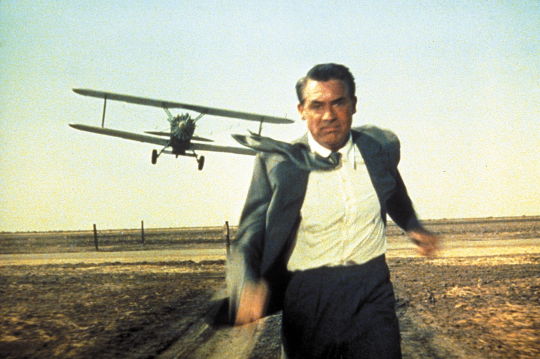
Cary Grant in North by Northwest (Alfred Hitchcock, 1959)
Cast: Cary Grant, Eva Marie Saint, James Mason, Jessie Royce Landis, Leo G. Carroll, Josephine Hutchinson, Martin Landau, Philip Ober. Screenplay: Ernest Lehman. Cinematography: Robert Burks. Production design: Robert F. Boyle. Film editing: George Tomasini. Music: Bernard Herrmann.
There's a famous gaffe in North by Northwest, in the scene in which Eve Kendall (Eva Marie Saint) shoots Roger Thornhill (Cary Grant). Before she fires the gun, you see a young extra in the background stop his ears against the noise, even though it's supposed to surprise and panic the crowd. It's so obvious a mistake that you wonder how the editor, George Tomasini (who was nominated for an Oscar for the film), could have missed it. The usual explanation is that he couldn't find a way to cut it out, or didn't have footage to replace it. And after all, in the days before home video, would the audience in the theater notice? Even if they did, they would have no easy way to confirm that they had actually seen it. But I have a different suspicion: I think that they showed the goof to Alfred Hitchcock, and that he laughed and left it in. For above all else, North by Northwest is a spoof, a good-natured Hitchcockian jest about a genre that he had virtually invented in 1935 with The 39 Steps: the wrong man chase thriller, in which the good guy finds himself on the run, pursued by both the bad guys and other good guys. The ear-plugging kid fits in with the film's general insouciance about plausibility. A couple who climb down the face of Mount Rushmore, she in heels (and later in stocking feet) and he in street shoes? A lavish modern house with a private air strip that seems to be on top of the mountain, only a few hundred yards from the monument? A good-looking man who seems to go unnoticed by the crowds in New York and Chicago and on the train in between, even though his face is on the front page of every newspaper? A beautiful blond woman who shows up just at the right moment to take him in and not only hide him on the train but also make love to him? Only a director with Hitchcock's skill and aplomb could take on such a tall tale and make it work, keeping you thoroughly entertained in the process. Of course, he had one of the greatest leading men of all time to work with and a leading lady with enough skill to evoke his favorite, Grace Kelly, without embarrassing herself. He had Bernard Herrmann's wonderful score, alternately pulse-pounding and romantic, and Robert Burks's cinematography. He had James Mason, Martin Landau, and Jessie Royce Landis as support. I would call it my favorite Hitchcock film, but only when I've just seen it, and my ranking will probably change the next time I see Notorious (1946) or Rear Window (1954) again.
6 notes
·
View notes
Text
North by Northwest (1959)
Director: Alfred Hitchcock
Starring: Cary Grant, Eva Marie Saint, James Mason
A New York City advertising executive goes on the run after being mistaken for a government agent by a group of foreign spies, and falls for a woman whose loyalties he begins to doubt.
Roger Thornhill is an advertising executive. When he gets kidnapped and is taken to a mansion, the kidnapper, Lester, addresses him…
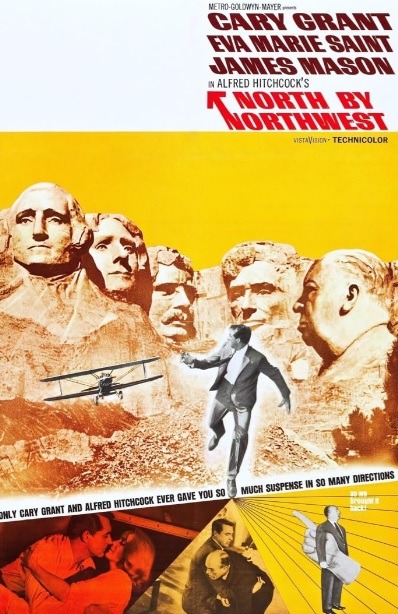
View On WordPress
0 notes
Text
~william cavendish the 4th earl and 1st duke of devonshire~
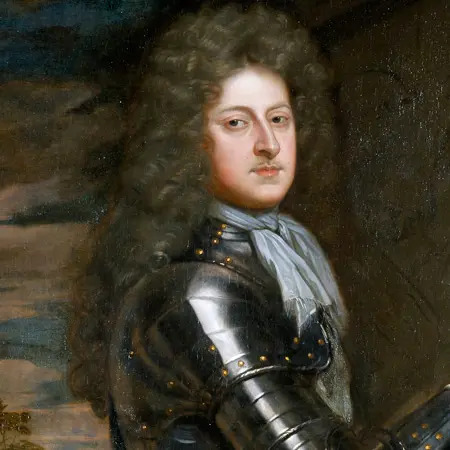
The 4th Earl of Devonshire did not inherit his title and his fourtune until he was 43 years old after the death of his father William, by the time william had gained his title and fortune he had already built a reputation for himself. He went on to marry Lady Mary Butler the daughter of James Butler and they had four children together. By the 1680s Chatsworth had fallen into a poor state of repair, and william the 4th Earl began to do some work on the old house. Initially, the intention was only to alter the South Front, which was taken down in 1686 and replaced with new family rooms and a magnificent State Apartment. However William found the building so enjoyable that the East Front was soon also rebuilt. William Talman was the architect for the South and East Fronts of the building. The West of the building was designed by the Duke himself, working closely with his masons, and the North, with its bow front, by Thomas Archer. Decorations by Antonio Verrio, James Thornhill, and Samuel Watson. The new Chatsworth was finished just before the Duke died in 1707. He was then succeeded by his eldest son, William.
Harvard referencing:
Encyclopedia (no date) The Diary of Samuel Pepys. Available at: https://www.pepysdiary.com/encyclopedia/13877/ (Accessed: 01 September 2023).
Glorious revolution (2023) Encyclopædia Britannica. Available at: https://www.britannica.com/event/Glorious-Revolution (Accessed: 01 September 2023).
William Cavendish, 4th Earl and 1st duke of devonshire (1641–1707) (no date) Chatsworth House. Available at: https://www.chatsworth.org/visit-chatsworth/chatsworth-estate/history-of-chatsworth/4th-earl-and-1st-duke-of-devonshire/ (Accessed: 01 September 2023).
0 notes
Text
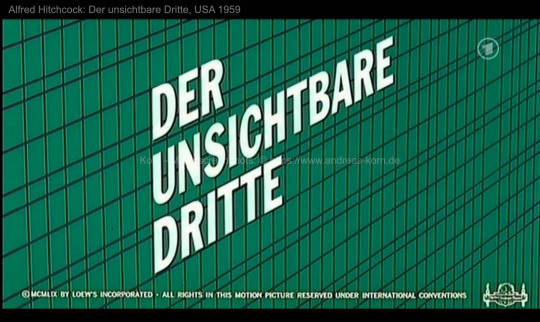

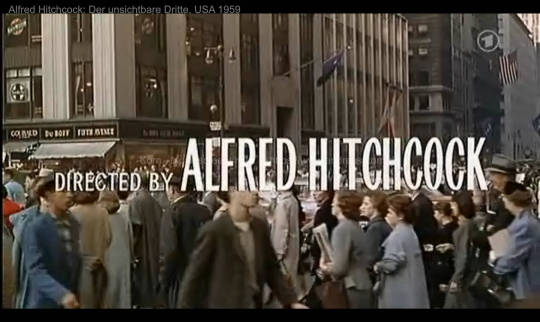

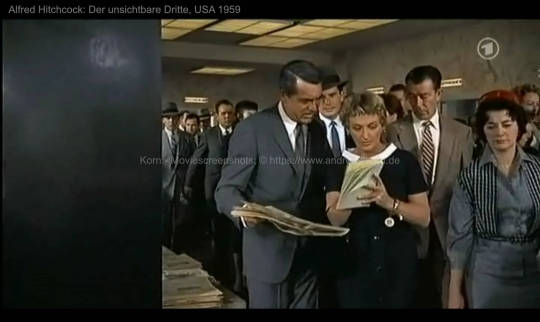


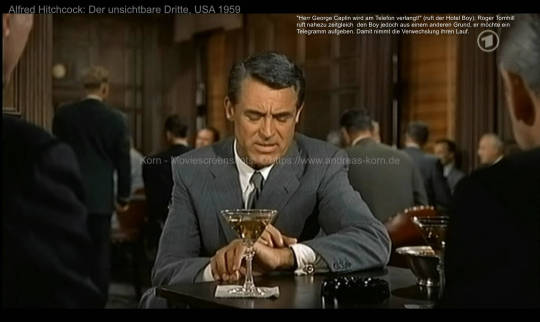


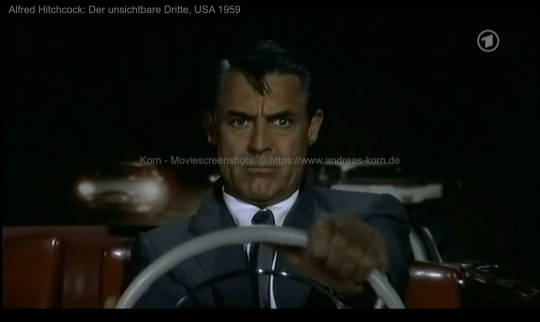


Der unsichtbare Dritte (USA 1959)
Regie: Alfred Hitchcock
Darsteller:
Cary Grant - Roger Thornhill
Eva Marie Saint - Eve Kendall
James Mason - Philipp Vandamm
Jessie Royce Landis - Clara Thornhill
Leo G. Carroll - Professor
Martin Landau - Leonard
Robert Ellenstein - Licht
Adam Williams - Valerian
Philip Ober - Lester Townsend
u.a.
----------------------
Movie Screenshots wichtiger Schlüsselszenen:
Selektion: Dr. Andreas Korn (Set 1; Abb. 01-13)
ANMERKUNG
Interessant sind Motiv Wiederholungen in Hitchcocks Film Plots: Telefonieren, Face Close-Ups, Autofahrten (meist mit einkopierten Umgebungsfilmsequenzen in den Autoscheiben), Kulissen und Bauten von Außenraumsituationen im Filmstudio (Stichwort: Künstlichkeit und Konstruktion filmischer Wirklichkeit); Verwechselungen (Der unsichtbare Dritte, Der falsche Mann, Vertigo) uva.
Bild 07 - Start der Verwechselung
Roger Tornhill ist mit 3 Männern verabredet. Einer davon scheint schwerhörig zu sein und kann nur sehr angespannt mit einer Hand hinter der Ohrmuschel als Verstärkung des Hörens folgen. Ich habe mich gefragt, was diese Szene bezwecken soll. Vielleicht wird einfach aus der Lebensrealität auch mal ein Verhandlungspartner mit Handicap (Schwerhörigkeit) ins Set integriert? Aber beim genaueren Hin- und Herspulen der Szene kommt mir eine andere Erklärung in den Sinn. In der Szene ist sehr bedeutungsvoll, dass der Hotel Page einen Ausruf macht, dass Herr Caplin am Telefon verlangt wird. Diese Szene geht aber im "Dschungel" der belebten Gespräche in der Hotel Halle sehr unter. Kurz: ich bin mir sicher, dass Hitchcock mit der Figur des Schwerhörigen eine besondere Aufmerksamkeit auf das Gesprochene lenkt. Erst nach mehrfachen Anhören konnte ich den Aufruf des Pagen richtig verstehen. Herr Tornhill scheint auf den Aufruf des Pagen zu reagieren, aber er sucht für sich ja eine Möglichkeit, ein Telegramm aufzugeben. Er dreht sich vom Tisch etwas zur Seite und sieht zufällig den Pagen hinter ihm im vollen Gastraum und bittet ihn mit erhobener Hand zu seinem Tisch. Das alles geschieht direkt, nachdem der Page seinen Aufruf getätigt hat. Zugleich beobachten in dem Gastraum 2 Männer den Aufruf des Pagen. Da offenbar Herr Tornhill darauf reagiert, denken die beiden, dass er der ausgerufene Herr Caplin ist, den die beiden suchen. Die folgenschwere Verwechselung nimmt ihren Lauf. Wer nicht genau hinhört, kann diese entscheidende Situation verpassen...
Dr. Andreas Korn, 07.08.2023
+++++++++++++++++++++++++++
[Tumblr hat leider den Fotoplayer drastisch im Gebrauch eingeschränkt. Wenn zuvor in einen Beitrag eine Vielzahl von Bildern integriert war, wurde beim Klick auf eines der Bilder eine Art "Galerie" gestartet. Hier konnte man bequem durch die Bilder durchklicken. Jetzt kann man nur ein einzelnes Bild in der Vergrößerung aufrufen. Man muß dann im Browser den "Zurück-Button" klicken, um zum Beitrag zurückkehren zu können. Das macht für User die Bildbetrachtung einer "Serie" aus meiner Sicht zu einer Zumutung. Dabei bewirbt Tumblr noch mit der Anmerkung, dass nun sogar "30 Bilder" einem Beitrag zugewiesen werden können. Da hat das Team überhaupt nicht nachgedacht und "Verschlimmbesserungen" ausgeführt! Vgl. dazu meinen Tumblr Beitrag vom 28. Juni 2023]
+++++++++++++++++++++++++++
* * *
0 notes
Text

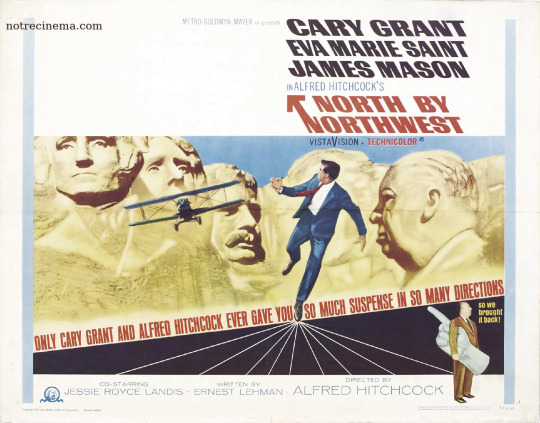
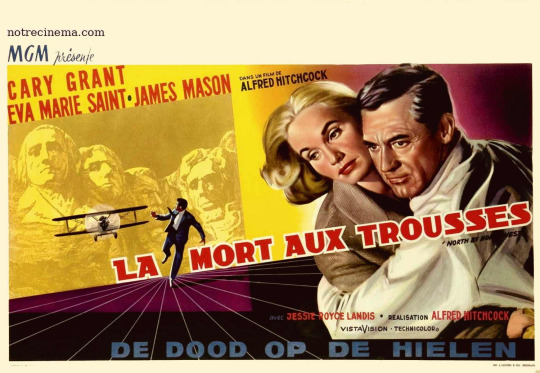
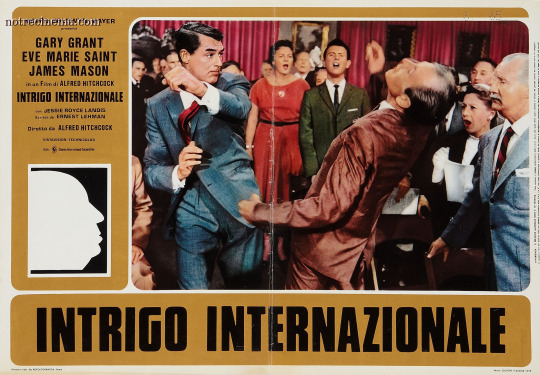
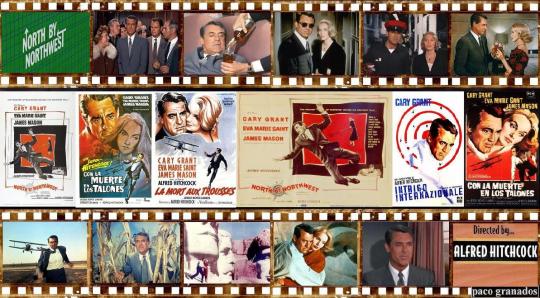

North by Northwest (1959)
Film
Thrillers
There’s no other thriller as elegant, light-touched and sexy as Hitchcock’s silken caper. Cary Grant’s suavely hollow adman Roger O. Thornhill (“What does the O. stand for?” “Nothing.”) is Don Draper with a sense of humor, which he sorely needs when he contracts a bad case of Wrong Man–itis. The set pieces, the villains, Eva Marie Saint’s femme fatale, Saul Bass’s credits, Bernard Herrmann’s musical cues—somehow the film manages to be even more than the sum of its glorious parts. Oh, and somewhere in there, Thornhill even manages to find his soul.—Phil de Semlyen
Read more North by Northwest
Time Out says 4 out of 5 stars
Fifty years on, you could say that Hitchcock’s sleek, wry, paranoid thriller caught the zeitgeist perfectly: Cold War shadiness, secret agents of power, urbane modernism, the ant-like bustle of city life, and a hint of dread behind the sharp suits of affluence. Cary Grant’s Roger Thornhill, the film’s sharply dressed ad exec who is sucked into a vortex of mistaken identity, certainly wouldn’t be out of place in ‘Mad Men’. But there’s nothing dated about this perfect storm of talent, from Hitchcock and Grant to writer Ernest Lehman (‘Sweet Smell of Success’), co-stars James Mason and Eva Marie Saint, composer Bernard Herrmann and even designer Saul Bass, whose opening-credits sequence still manages to send a shiver down the spine.
Hitchcock breezes through a tongue-in-cheek, nightmarish plot with a lightness of touch that’s equalled by a charming performance from Grant (below), who copes effortlessly with the script’s dash between claustrophobia and intrigue on one hand and romance and comedy on the other. The story is a pass-the-parcel of escalating threats, all of them interior fears turned inside-out: doubting mothers, untrustworthy lovers, vague government handlers, corrupt cops. Within minutes of the film’s opening, shady strangers in a hotel lobby mistake Thornhill for a ‘George Caplin’ and from there we sprint from country house to the United Nations, from the ticket hall of Grand Central Station to Mount Rushmore in South Dakota. Thornhill’s ignorance of his fate and complete lack of control offer Hitchcock a brilliant blank canvas on which to experiment with a story that would sound ludicrous on paper, yet it feels like anything’s possible in Lehman’s playful script. ‘I’m an advertising man, not a red herring,’ says Thornhill. He couldn’t be more mistaken.
Written by Dave CalhounTuesday 16 June 2009
Director: Alfred Hitchcock
Screenwriter:Ernest Lehman
Cast:
Cary Grant
Eva Marie Saint
James Mason
Leo G Carroll
Jessie Royce Landis
Josephine Hutchinson
Philip Ober
Martin Landau
Adam Williams
Ed Platt
0 notes
Text
Fri[day] 7 October 1836
6 50/..
12
V
P
L
No kiss fine b[u]t dampish and rath[e]r hazy at 7 50/.. when w[e]nt d[o]wn to the paint[e]r who h[a]d been siz[in]g the hall tab[le] –
out – ab[ou]t till br[eak]f[a]st at 8 55/.. in 20 min[ute]s - then w[i]th A- [Ann] till 9 35/.. at w[hi]ch h[ou]r F[ahrenheit] 53 1/2° - Mr. Washington
ca[me] to ent[e]r his acc[oun]ts of this y[ea]r in my new cash b[oo]k to be beg[u]n by him fr[om] the 1st of this y[ea]r –
so[me] ti[me] look[in]g out his bills and for the last midsumm[e]r rental w[hi]ch I now recoll[ec]t that he has nev[e]r
giv[e]n me b[a]ck – H[a]d Mr. Jubb bet[ween] 11 and 12 - A- [Ann] bet[ter] aft[e]r h[e]r 2 cal[omel] pills (2 gr. cal[omel]) of last
night - my a[un]t weak[e]r – so[me] ti[me] bet[ween] 12 and one w[i]th Rob[er]t Mann + 3 (Jack and Sam and the new man) – Matt[hew] n[o]t co[me] –
means to slip away like Wood - let him and ha[ve] told Rob[er]t to employ him no mo[re] here –
Ingh[a]m and his man and boy at the upp[e]r dry arch wall[in]g - 1 mason at the west tow[e]r cellar stairs, and Ja[me]s
and Ab[raha]m finish[e]d Hall staircase wind[ow] - the four York joiners tak[in]g out the 2 hall chamb[e]r floor
big beams - Mark Hepw[or]th and Hutchinsons one h[or]se cart – cart[in]g stuff to old paddock top
and br[ou]ght each a load of rubble in the morn[in]g and gone for lagg[in]g stuff this aft[ernoo]n - Frank cart[in]g
st[one] for Jos[e]ph Mann at the Long goit – h[a]d just writ[ten] so far of today at 2 1/4 p.m. - settled
w[i]th Mr. SW- [Samuel Washington] and p[ai]d h[i]m £40.4.2 in full fr[om] up to today inclus[ive] - the f[iel]ds he w[oul]d like A- [Ann] to
buy belong[in]g to Mr. Harris[o]n are 2 n[ea]r Southedge farm 5DW val[ue]d at £335 and 1 f[iel]d 1DW opp[osi]te
to Southedge farm £105 and SW. [Samuel Washington] hims[elf] w[oul]d gi[ve] £600 for the 7 or 8 cot[tage]s at Hove edge w[i]th the 6DW
of delph-hill – f[ou]nd the last midsumm[e]r rental in my new Rentbook, and ga[ve] it Mr. SW- [Samuel Washington] to ma[ke] out
a regular rent[a]l as us[ua]l - told SW- [Samuel Washington] I hardly th[ou]ght the f[iel]ds and cott[age]s etc. w[oul]d be sold at the pr[ice] he h[a]d val[ue]d
them at - I w[oul]d buy on his val[uatio]n blindfold - selling w[a]s anoth[e]r th[in]g –w[i]th one or oth[e]r - (a lit[tle]
whi[le] in the stab[le] and ord[ere]d the carr[ia]ge horses n[o]t to be kept sheet[e]d) fr[om] 3 to 6 1/, in spi[te] of the r[ai]n - stood
out w[i]th Rob[er]t Mann + 3 mend[in]g up the road to the h[ou]se thro’ the carr[ia]ge court, and watch[in]g the masons’ boy
pile up bricks and w[i]th Ingh[a]m wall[in]g - he sadly afr[ai]d of gett[in]g wet – D[i]d up A-‘s [Ann] parcel rec[eive]d this
morn[in]g a cachemire [cashmere] black embodied scarf with full half sheet familiar note from Lieute
nant Peterson eleventh dragoons Burlington written inside one of the paper wrappings
A- [Ann] indignant at both note and present sent back the latter tonight by Frank directed
by me to the ‘Lieutenant etc etc Wakefield 7 October’ not a line or syllable written
in answer and A- [Ann] burnt the note after dinner din[ner] at 7 – coff[ee] upst[ai]rs - I sat w[i]th my a[un]t fr[om] 9 to and dur[in]g
this ti[me] cop[ie]d int[o] bus[ine]ss Let[ter] b[oo]k my let[ter] to ‘Mrs. Bull 3 Friargate Derby p[ost]p[ai]d’ s[e]nt by Frank tonight - and wr[ote] the last 15 lines –
Mr. Harris[o]ns’ prop[ert]y
228
1836
Oct[obe]r
L
ga[ve] up the th[ou]ght of Sarah Parker and ask[e]d Mrs. Bull to look out for a h[ou]sekeep[e]r – let[ter]
tonight fr[om]............ (can[no]t ma[ke] out the na[me]) recomm[endin]g Fanny Hardy as an excel[en]t cook
liv[e]d 6 y[ea]rs w[i]th a Miss Thornhill wages w[i]th her £15. sat mak[in]g writ[in]g out acc[oun]ts (coll[ie]ry d[itt]o
p[ai]d on Mond[ay]) till 10 1/2 - my a[un]t seems m[u]ch the sa[me] as she w[a]s last night – n[o]t appar[entl]y worse - fine
day till bet[ween] 3 and 4 p.m. (soon aft[e]r 3) and aft[er]w[ar]ds rain - then aft[e]r a lit[tle] gleam rainy ev[enin]g fr[om] 5p.m.
F[ahrenheit] 50° now at 11 p.m. hav[in]g been 20 min[ute]s in my study arrang[in]g my bills etc
Fanny Hardy
1 note
·
View note
Text
Awww. That was a nice ending
4 notes
·
View notes
Photo

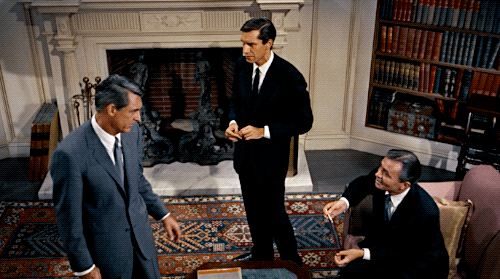

ADVENT CALENDAR 2020✨FAVOURITE SCENES
19/24 North by Northwest (1959): Mr. Thornhill’s peculiar conversation with his kidnapper
Vandamm: Now, shall we get down to business?
Thornhill: I’m all for that.
Vandamm: Quit simply, I’d like you to tell me how much you know of our arrangements and - of course - how you’ve come by this information. Naturally, I don’t expect to get this for nothing.
Thornhill: Of course not.
Vandamm: Don’t misunderstand me. I don’t really expect you to fall in with my suggestion, but the least I can do is afford you the opportunity of surviving the evening.
Thornhill: What the devil is that suppose to mean?
#advent calendar 2020#favourite scenes#19/24#north by northwest#mr. thornhill’s peculiar conversation with his kidnapper#alfred hitchcock#cary grant#martin landau#james mason#storytelling#acting#deep feelings#the mood of the conversation varies from polite to weird#vandamm is the spokesman the brains#leonard is the secretary the right hand#ready to do as instructed#here thornhill and vandamm is having a chat#and leonard observes their kidnapped victim#a viewer is as confused as thornhill#so well scripted#own gif#own post
15 notes
·
View notes
Text
Cheryl//this is me trying
Request: Can I request a season 1 cheryl x reader. Cheryl always protects reader from people and r is shy but falls in love with the redhead and some who’s accidentally tells her while she’s having a bad day but cheryl is quick to reassure her then they cuddle after going to pops or something and it’s just fluffy.
hey! happy valentines day gays! and get you, two imagines in one day, it must be the day of love. i hope you all like this because it’s really fluffy and i enjoyed writing this a lot!
Overnight, Riverdale became a shell of its former self. Two months since Kevin Keller and Moose Mason stumbled upon the body of Jason Blossom, and nobody has been the same since.
The town is riddled with secrets, they’re slowly destroying it like a disease. Nobody trusts anybody anymore, everyone is on high alert, and everyone is a suspect.
Cheryl usually loves being the centre of attention, she has done ever she was a kid. It’s something that comes naturally with being a twin, you share everything and as much as she loves loved the shared birthdays and friends, she has always loved being the centre of attention.
Now however, she hates it. Her life is a true crime documentary at the minute, and all she wants is for the killer to be caught so the crew can pack up and leave and she no longer has to stare down at the blinding lights being cast over her and her family.
The only thing that’s kept her sane over the past two months, is you. Despite everything happening, despite the murder and the secrets and the suspicion, you’ve stuck by her side. You were with her when they found the body, and you haven’t really left since.
The two of you are unlikely friends, she’s Cheryl. Bright and bold and never one to back down from confrontation. But you’re Y/n, sweet and shy and always the first to shrink away from any sort of attention directed at you.
She knows you hate the constant attention recently, it’s something you get used when you’re best friends with the victim’s sister, but not once have you complained.
You’ve being questioned by police, journalists and strangers on the internet. You’ve had camera’s shoved in your face on your walk back from school and been asked countless questions about what you know about the Blossom’s. And you’ve also been offered ridiculous amounts of money in order to talk. But no matter what happens, you always just rush past them and join Cheryl, who’s always waiting for you with a sad smile and warm hand.
Due to the constant hoard of vultures swarming Riverdale High, the two of you had to figure out somewhere else to meet after school so you could walk the long way home. It adds twenty minutes to your walk, but it’s not that well known around town, meaning people can’t bother you.
Plus, the extra twenty minutes that you get to spend with Cheryl isn’t the worst thing. It’s the opposite in fact. It’s the thing you look forward to, even if you are looking over your shoulder every so often
But today you’re not at your meeting spot.
When Cheryl pushes her way through the stares of her fellow students with you and only you on her mind and makes her way through the school basement, back up the stairs and out of the fire exit, you’re not waiting for her with a smile that makes her feel warm and a cold slice of pizza you snuck out of the cafe earlier.
The only thing waiting for her is a full bin and an empty field.
“Y/n?” She calls out and looks around the corner. She’s met with three seniors, all of which are smoking with absolutely no care for being caught.
“She’s not here.” One of them says, her blonde hair and large glasses cover half of her face and Cheryl forces a smile.
“Hey, Blossom.” A boy says and Cheryl freezes. Who knows what they want, but whatever it is, it probably won’t be nice. It’ll probably be something along the lines of ‘hey, did you kill your brother’ and no matter how many times she’s asked that, it doesn’t get any easier. “Maybe try the bleachers.” He says, ending his sentence with a sympathetic smile and Cheryl nods slowly, not really sure what to say.
“Thanks.” She forces and spins on her heel.
“We’re sorry about your brother, Cheryl.” The blonde one says and she turns around again. Each of them look sad, with matching frowns and sorrow swimming in their eyes.
Jason meant the world to Cheryl, but he also meant a hell of a lot to other people too. And that’s when it hits her. Of course you’re at the bleachers.
For some bizarre reason, only known by your father. You and your family used to come along every other week to watch the Bulldogs play. For a while you thought it was because your dad was trying to get you and your brother into football and this was a lot cheaper than the actual game, but the older you got the more you figured it was because he was just trying to relive his youth. For 90 minutes he could pretend that he was quarterback again and for those 90 minutes your dad would be the happiest he’d been all week.
Then one week, a redhead sat beside you. In clothes that were far too expensive to be worn to a high school football game. Her parents looked like they wanted to be there as much as she did, but then a boy with matching red hair ran out on to the pitch and you’d never seen a smile quite like it.
After that, you made sure to sit beside her at every game. And then one day she sat opposite you at lunch. The first few times she was alone, but then soon she began to appear with a group of other girls, but you were the only one she’d talk to.
Eventually lunch times and football games turned into group projects and sleepovers. You spend hours braiding her hair and listening to her tell you stories of other worlds and the creatures that live in them. You’d sneak down the dark and creepy halls of Thornhill in hopes of finding a midnight snack, and instead be met by Jason and your older brother in clown masks.
Eventually, you found a different way to get to the kitchen, one that Jason didn’t know about. And when he’d come looking for you, both of you would jump out and chase him around the house, much to the dismay of Penelope and Clifford.
Those bleachers are what started a whole friendship, not only between you and her, but also you and Jason. When you’re brother eventually made the team, thanks to a good word put in my Jason, despite him being a year younger. Him and Jason became as inseparable as you and Cheryl and so it wasn’t an uncommon occurrence to see the four of you hanging out. It also meant that if Cheryl was busy, you and Jason would hang out until she finished whatever she was doing.
Grief is a hell of a lonely thing, and sometimes Cheryl forgets that other people miss Jason too. With everything going on, she didn’t even think about how you were doing. With all the questions, accusations and crying that constantly fills Cheryl’s house. She never even asked how you were.
And now her legs can’t carry her quick enough to were she hopes your sat. Because she’s already lost her brother, she can’t lose you too. She wobbles as her heels dig into the dirt, kicking up dust and mud as she runs across the field. Her hair swings behind her, and she can feel the red scrunchie loosen the quicker she runs.
The bleachers have all sorts carved into them. Initials in hearts, some of them still there, some of them crossed out so aggressively that it’s a miracle they didn’t chop it in half. There’s inside jokes and ridiculous rumours. Codes and dates and everything in between.
But something new has been added in the past few days.
cheryl murdered jason
and y/n helped
The writing is small and barely legible, but it’s there and the more you run your fingers over it the more it carves itself into your heart.
“Y/n?” Cheryl pants breathlessly and you quickly pull yourself away from it. Instead you stand up properly and pull the sleeves of your sweater down over your hands. The y/f/c scrunchie remains still in your hair and Cheryl has to stare at it for a few seconds to calm herself down. “You weren’t at our spot.” She says quietly and you close your eyes.
You let her down. You let her down. You always let her down.
“Sorry Cheryl.” You sigh and sit down in the dirt. Cheryl looks around before sitting beside you. “I just wanted some space.” You add and force yourself to look at her.
The sun sits behind her, but even that doesn’t seem as bright as it used to be. Nothing is what it used to be. For the past two months, you’ve been told that thats a good thing. But what’s good about someone you loved being dead. What’s good about watching someone else you love go through life but not really live.
Cheryl just exists.
But she exists for you.
Because as lost as she would be without you, she knows you would be just as lost without her.
It’s an unspoken rule now, you always text each other when you wake up and before you go to sleep. It’s something you used to do anyway, but now you make a point not to forget. Because forgetting means that the worst could have happened, and that’s something neither of you can bare to deal with.
“I get it.” She nods. “I was just worried that’s all.” She adds, trying to sound as casual as she can. But on the inside she’s screaming. Because she thought you had died, she thought whoever had killed Jason had gotten to you too, and the whole reason you’re both dead is because she wronged the wrong person.
There’s a lot of people that don’t like Cheryl, being unliked comes naturally to her. But she doesn’t know how she’ll cope if she’s so unlikeable someone she loves died.
She has no idea why your friends with her to be honest. She saw you staring at her at a football game once. But it wasn’t a stare she was used to. It wasn’t cold like her mothers or jealous like her friends. No, this was nice. You were staring at her like you wanted to know about her, like when you looked at her, you saw a friend not someone to be feared.
And so Cheryl clung onto the tiny hint of friendship, the crack of a door into something that could happen, and she shoved herself through it. It worked, and now you’re the only person she’s nice to. She’s mean to everyone else, she calls them names and teases them, especially when they’re rude to you...but you stay. And she has no idea why, but she’s not going to wish it away.
“Shit, sorry Cheryl.” You drop your head into your hands and Cheryl looks at you confused. She looks around, not really sure of what to do. “I didn’t think, God knows what you thought had happened.” You ramble and she realizes you’re crying. Her eyes widen and you look at her, your eyes red and puffed and your lips pulls into frown.
“It’s okay.” She replies and wraps her arms around you. You bury your head into her neck, the smell of maple and cherries invade your senses and you let out a shaky breath.
It smells like home and happier times, and you want to crawl into those happy memories and never come back out. “I was just being ridiculous.” She tries to play it off, to make it seem like she couldn’t feel her heartbeat in her throat and the ringing in her ears. Pretend like it didn’t feel like someone had pulled her heart out and stamped on it.
“No, no you weren’t. I’m really sorry.” You sob and wrap your arms around her. She falls into your neck, surprised but not upset with how tight you’re holding her. She never wants you to let go. But of course she has to, and so however reluctant, she untangles herself from you and lets out a deep sigh.
“I’m sorry.” You sniffle. She hands you a tissue and you wipe your eyes with it before scrunching it up in your hand. “I’ve just had a rubbish day. Somebody shoved this in my locker.” You frown and pull a balled up piece of paper out of your pocket.
Cheryl’s eyebrows knit in confusion as she takes it from you, her fingers graze yours and you freeze for a few seconds.
who do you think did it?
cheryl __
y/n __
Jamie __
“Why is your brother on here?” Cheryl asks, her voice rising with each word and you rest your hand on top of hers to calm her down.
“I dunno.” You shrug. “Your parents are on there too.” You add and point further down the page.
“What a bunch of dicks.” She grumbles and crumples it up. “Do you know who it was?” You shrug and she sighs.
“I’ve just gotten tired of the staring and the whispers. So I thought I’d just have five minutes peace before going home and having to listen to Jamie cry in his room but pretend he’s okay. Or for my parents to walk on eggshells around both of us. Neither of them know what to say, and because of that they keep saying the wrong thing.” You ramble and she listens intently, trying her best to find a resolution to all of your problems.
Unfortunately, she doesn’t know the answer to everything, no matter what her mom says.
“I just thought five minutes by myself can’t be terrible. But then I came down here and someone carve-well it doesn’t matter what they wrote. What matters is that I made you worry at the worst possible time in your life. I hurt you, and I’m really sorry. Believe me, hurting you is the last thing I want to do you. I feel sick even just thinking about it. I never, ever want to hurt you. I love you too much. I love you more that I’ve ever loved anything or anyone ever. I just love yo-” Your eyes widen when you realize what you’ve just admitted to.
You don’t want to look at her, but she hasn’t said anything in a while and that’s strange for her. So you force yourself to look at her, expecting the worst. Expecting disgust, disappointment, betrayal. But it’s none of those.
Instead she’s smiling. And she looks actually happy. Something you haven’t seen in so long, something you’re glad to see, despite the circumstances.
Oh yeah, you’ve just told her you’re in love with her. What do you say after that?
“I-er-”
“Y/n?” She cuts you off before you get the chance to ruin the moment. She’s known you for long enough to know that when you get nervous, you ramble and when you ramble you say weird things.
You’re grateful for her cutting you off, usually if she talks over you, it annoys the hell out of you. But this time it’s welcomed and she stifles a small laugh and the sigh of relief you let out.
But the next thing she says is something that you weren’t expecting, but you’re sure as hell grateful for.
“Would you like to go on a date?”
---
The red lights from outside, illuminate Cheryl’s pale face in the night, painting her in a reddish hue and you find yourself staring at her for far longer than would be considered normal.
Lucky for you, she hasn’t noticed. She doesn’t seem to be paying attention to anything, not really anyway. Instead she stares down at her food, pushing a few fries around the plate and anxiety rises in your chest.
She’s already regretting doing this. She’s made a mistake and now she doesn’t know how to let you down gently.
She seems to sense you nerves because she’s looking at you quickly, a sad smile twitching at her lips.
“Sorry, I just. Jason always used to tease me about the two of us. It’s the only thing we’d take about sometimes. He’d constantly ask me if I’d asked you out yet. And every time I would say ‘no, we’re just friends’ but, well neither of us really believed that.” She says, a small laugh escapes her lips near the end, but she quickly shuts it off. It’s too soon for her to be laughing, too soon for her to be happy.
“Yeah.” You nod and finish your drink. “He used to tease me too. ‘if you don’t tell her, I’ll do it myself’.” You mimic his voice and a ghost of a smile twitches at her lips as she forces herself to look at you. “I am really glad you did ask me though.” Your voice shakes a little with nerves and Cheryl stares at you confused. “I do really like you Cheryl.”
“I really like you too.” She smiles softly and you stare at her lips. Sometimes you think the red lipstick has permanently stained her lips cherry red. Even when you guys are a sleepover, she still has bright red lips and the other part of you wonders if that’s just what they look like.
“Hey.” You start and a sly smile twitches at your lips as you remember an old memory. She leans forward, excited to know what you’re smiling about.
It could literally be anything, from a musty old book she let you borrow from the Thornhill archive, to a new tv show you started to watch. But whatever it is, she’s excited to hear you talk about it.
“Can you remember last year. It was Jamie’s 16th birthday and you and Jason were invited over. Jason was there because him and Jamie were planning on sneaking out later that night, and you tagged along so you could keep me company.” You start and she smiles at the memory.
The four of you sat in the living room, while your mom brought cake and your dad sang ‘happy birthday’. Cheryl remembers how happy she was, and she remembers talking to Jason afterwards, the two of them whispering and wondering if that was what a normal family was supposed to look like.
You, Cheryl and Jason had each pitched in for the record player he wanted. And even though you all knew that just Cheryl alone could have been able to buy him it if she really wanted, you knew they split it for you.
Jamie was ecstatic when he opened the box, and then all of the records you’d bought to go with it. He’d played it every single day since getting it, but now you haven’t heard it in months.
“Yeah.” She nods, a sad smiling taking over he face. “Can you remember when Jason pushed his face into the cake.” She adds making you snort a laugh.
The bell above Pop’s rings and Betty and Archie walk in. They send you a sympathetic smile before sitting at their own booth, and you and Cheryl share a look.
“Would you like another one?” You point at her milkshake and she nods, smiling shyly.
---
The walk home is over far too soon, and it’s only when you’re standing on your porch do you realize you took the normal way home by accident. Either the media has gone to sleep, or people are starting to forget about Jason and Riverdale.
That thought makes you frown and Cheryl watches your expression falter before you look back at her again.
“Thank you for walking me home.” You smile shyly and a nervous laugh escapes her lips.
“It’s no problem.” She shrugs and the two of you stare at each other for a few seconds longer than normal. She’s about to leave when you grab her hand and spin her around to face you.
She’s surprised for a second, until suddenly she feels a pair of lips on hers, and then the only thing she can feel is them. Everything else disappears, and though the kiss is short and a little awkward, it’s still perfect.
“Would you like to come in?” You ask and motion your head to large wooden door. The pain is chipped around the metal numbers, something your mom has nagged your dad about for the past 6 months. “We still have the rest of y/f/s to watch.”
“I’d love to.” She nods and the two of you grin at each other. “But seriously, how many times have you seen that now?”
“It doesn’t matter how many times I’ve seen it.” You unlock the front door, giving it a quick kick before you stumble through it. “What matters is that this is the first time you’re seeing it.” You add and she rolls her eyes but follows you up the stairs anyway.
The sun sets over another day in Riverdale and darkness floods the town. The streets are cold and scary, but wrapped in your duvet and Cheryl’s arms, you’ve never felt warmer.
#cheryl blossom#cheryl blossom imagine#cheryl blossom x reader#cheryl blossom x y/n#cheryl blossom x you#riverdale#riverdale imagine
183 notes
·
View notes
Text
North by Northwest (1959); AFI #55
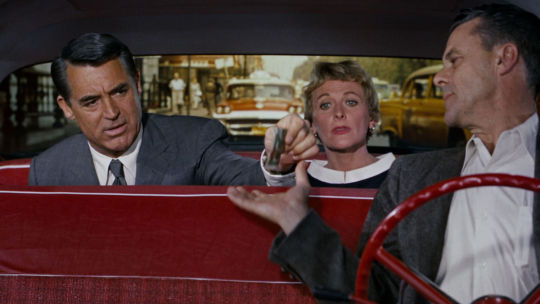
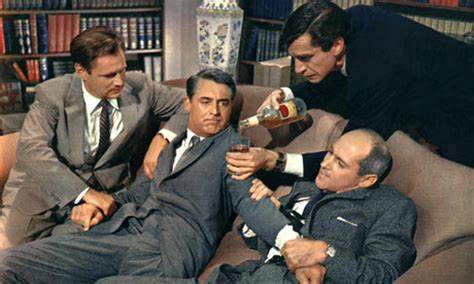
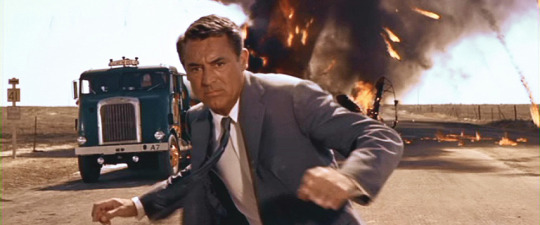
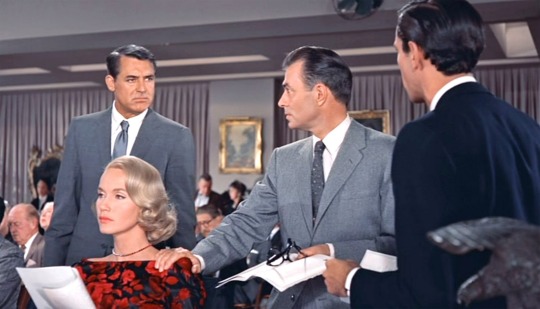

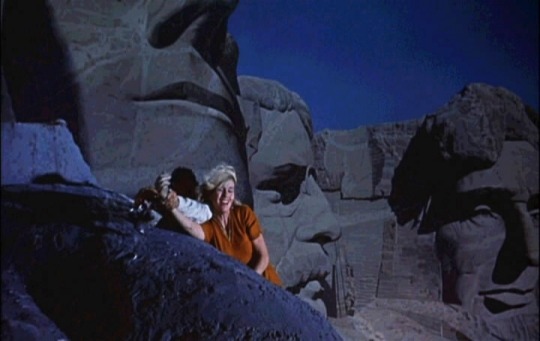
The next film for review was the Hitchcock classic North by Northwest (1959). This movie has possibly the most well known surprise attack scene in American cinema involving a crop duster. I know, it sounds great. The film was moderately successful at the box office and marked the one and only time that Alfred Hitchcock worked with MGM. It was also only one of two VistaVision films made at the studio. Hitchcock was not a man to let studios mess with his work, so he famously refused to cut 15 minutes out of the movie for time and instead cut a total of 5 seconds worth of material. Before I go into any more detail, I feel like this is bordering quickly on spoilers so let me get the warning and the synopsis out of the way:
SPOILER ALERT!!!! THIS IS A GREAT MOVIE THAT I KNOW VERY WELL AND FEEL LIKE IT SHOULD BE SEEN BEFORE IT IS DISCUSSED!!! I AM GOING TO GO OVER THE FILM IN GREAT DETAIL SO CHECK IT OUT BEFORE READING ANY FURTHER!!!
-----------------------------------------------------------------------------------------------------
The whole story begins with a case of mistaken identity. Roger Thornhill (Cary Grant) is an advertising executive who is going to lunch to have a business meeting. He sits down and then remembers he needs to phone his mother so he summons the waiter to ask about a phone. Apparently the waiter had just received a call for a spy named George Kaplan and some thugs are waiting for a signal that will identify the man. Thornhill’s signal is mistaken for the spy’s and the thugs move in and take away the ad exec at gunpoint. They go to the home of U.N. Diplomat Lester Townsend and Thornhill is interrogated by a spy named Philip Vandamm (James Mason) and his right hand man Leonard (Martin Landau). Thornhill tries to say he is innocent, but Vandamm and the thugs do not believe him and stage his death by drunken car accident. Thornhill survives and escapes by car, but he is still drunk and is subsequently stopped and arrested by the Glen Cove police for drunk driving.
Thornhill sleeps off his intoxication at the station and calls his mother to get in contact with their lawyer. The next day, Thornhill tells the local court everything that he remembers happening, but nobody believes him. He even takes them back to the house and a woman claiming to be Townsend’s wife acts like Thornhill was there for a party and left drunk. Thornhill has to pay the fine (a whole $2), but he is still curious.
Thornhill and his mother go back to the restaurant where he was kidnapped and finagle their way up into the attached hotel to find the real spy, George Kaplan. It turns out that nobody has ever seen this man in person so everybody just assumes that Thornhill is Kaplan since he showed up at the room. The thugs have returned and try to recapture Thornhill still thinking he is Kaplan, but Thornhill is able to escape. He goes and visits the UN to talk to Townsend in an effort to shine a light on the situation, but Townsend is confused and says that his wife died many years ago. Suddenly, a knife is thrown into the back of Townsend and all the witnesses around think that Thornhill did it as there is nobody else to blame. Thornhill again escapes and is now running away and trying to find Kaplan in hopes of clearing his name.
I very quick scene of an American intelligence agency meeting reveals that Kaplan never existed and that this was a made up spy to keep Vandamm occupied while they figure out his plans. It is unfortunate for Thornhill, but all agree that he will have to become Kaplan and more than likely die by the hands of Vandamm and his men. Thornhill is unaware of this meeting and continues to run around looking for this non-existent spy.
Thornhill is able to sneak on a train to go to Chicago since he believes that Kaplan is at a hotel there. He runs into a lovely blonde named Eve Kendall (Eva Marie Saint) who seems aggressively interested in him and wants to help him hide out. She knows that he is the man who is being blamed for the murder of the UN diplomat and she seems to want to sleep with him (like a groupie)? She is very straight forward and it turns out that this is because she is working for Vandamm, who is also on the train.
In the morning, Eve helps Thornhill arrange a meeting with the non-existent Kaplan at an isolated rural bus stop outside of the Chicago. Thornhill gets there and finds...nothing? A guy shows up but he is just waiting for the next bus. The only thing around is a biplane crop duster that seems to be dusting empty fields. It dramatically turns and swoops down at Thornhill firing a backloaded machine gun. Thornhill is able to hide in the fields and then manages to get under a passing oil truck, which the biplane smashes into and eventually explodes.
Thornhill steals a truck and reaches Kaplan's hotel in Chicago to discover that Kaplan had already checked out and left before the time when Eve claimed she talked to him on the phone. Thornhill goes to her room and confronts her and she plays naïve. She tries to run away while he is changing clothes, but he quickly follows her down to an auction where he finds her with Vandamm. He insults her coldly and then makes his escape from Vandamm by turning himself in, but the police strangely won’t take him to the station and instead leave him in the care of a man simply called The Professor (Lee Carroll).
The professor finally reveals to Thornhill that Kaplan doesn’t exist and that Eve is actually a government agent working for the U.S. It is also explained that Vandamm has some sort of evidence/information that he is trying to take out of the country and will be leaving by plane from his South Dakota home that is in the woods right next to Mount Rushmore. The Professor leaves Thornhill to play the role of Kaplan and negotiates for Eve at the Mount Rushmore visitor center and she seemingly shoots him to look good in front of Vandamm. Luckily the gun is loaded with blanks (remember this gun, it will come back).
Afterwards, the Professor arranges for Thornhill and Eve to meet and Thornhill learns that she must depart with Vandamm and Leonard on a plane. When Thornhill tries to dissuade her from going, he is knocked unconscious by another one of The Professor’s men and locked in a hospital room. Thornhill is able to escape (he gets out of everything) custody and goes to Vandamm's house to rescue Eve from leaving.
At the house, Thornhill sneaks around and overhears that the sculpture that Vandamm bought at the auction holds some kind of microfilm. Leonard also reveals to Vandamm that the gun was a blank and it is decided that Eve will be killed on the plane. Thornhill must keep Eve from getting on the plane so he gives her a note revealing the plot. She is being lead out to the plane and she makes a break for it, meets Thornhill, and they climb out on to Mount Rushmore to escape. The Professor rushes in with his men and arrests Vandamm while also shooting Leonard.
Unfortunately, Eve has slipped climbing around on the president faces and Thornhill is attempting to pull her back to safety when...he is now suddenly pulling her onto a foldout train bed and he is calling her Mrs. Thornhill. The train enters a tunnel and the movie ends.
---------------------------------------------------------------------------------------------------
This was the fourth and lowest rated Hitchcock film on the AFI top 100, but I opine that it is the most fun. The constant escapes and the almost relatable situation of a businessman getting wrapped up in something of which he wanted no part of makes this a very easy watch. There really are no slow points in this film and the action is punctuated by good comedy. Drunken Thornhill trying to explain what happened and then desperately bidding at an auction to bide time for an escape his hilarious. My favorite line in the film is when Thornhill and The Professor are waiting at the Mount Rushmore visitor center and Thornhill looks through a viewing scope and says “I don’t like the way that Teddy Roosevelt is looking at me.” That is awesome.
As much as Alfred Hitchcock was the Master of Suspense and the King of Dramatic Climax...his endings aren’t generally very good. He did a terrific job wrapping up Rear Window (1954), making sure all storylines were finished, but he really didn’t end North by Northwest (1959), Vertigo (1958), or The Birds (1963). The movie Psycho (1960) did have an ending, but it was an exposition dump that really was the low part of the film. I love all of these films and the suspenseful build-ups to the dramatic climaxes are extraordinary and put them in a class of their own, but I would not call Hitchcock one to demand a satisfying resolution.
I know that I have done it for every one of the Hitchcock movies on the AFI list, but I again want to give a shout to Saul Bass for the opening credits and Bernard Hermann for the score. The intro to a Hitchcock film puts you in the mood for a good story and the score keeps you interested all the way to the end.
There were some questions from my parents as well as from a couple of viewers about the biplane scene. How was it that the plane passed by and then machine gun fire followed? Well, the plane was a N3N Canary, also known as the “Yellow Peril,” and was a tandem seat training biplane that had an open cockpit. This means that there had to be a a guy in the back with a gun shooting backwards. These were generally converted for agricultural use at the end of WW2. The plane that blew up was a different plane (a Stearman Boeing Model 75 trainer) that was also used as an agricultural duster. Empire magazine rated this scene as the greatest movie moment of all time.
Now that the group has been watching so many movies from Old Hollywood, it became apparent to me how extraordinarily dirty the language was on the train between Roger and Eve. I remember reviewing this film in a college film course and the professor commenting over the scene. She mentioned that this was the only scene of the film that had any cuts and they were made by Hitchcock himself. I also remember Eva Marie Saint saying she was 26 and the professor said, “Ha! Plus 10!” This was a mid 20s female character (played by an actress in her 30s) trying to actively bed a character in his mid 40s (played by an actor in his 50s) who she has just met and spent a total of 5 minutes with. It was all sorts of awkward, and it was great.
So. Should this move be on the AFI top 100? Yes. Probably higher in rank. I was just thinking of another Cary Grant film that is higher on the list, The Philadelphia Story (1940), and how this film is so much more fun. I think that there are other Hitchcock films like Rebecca (1940) and The Birds (1963) that could be on this list, but I guess 4 films from a director that isn’t American is a good representation. North by Northwest is definitely a deserving example. Would I recommend it? Yes. Heck, you can borrow my copy as long as you bring it back. I have seen the film probably two dozen times in the last 20 years and I would be happy to see it again if it means somebody can experience it for the first time. I highly recommend checking it out for yourself.
#alfred hitchcock#cary grant#eva marie saint#james mason#north by northwest#afi top 100 movies#movie review#film critique#synopsys#best movie scenes#introvert#introverts#film stills#spoilers
39 notes
·
View notes
Text
1001 Películas: North by Northwest (1959).
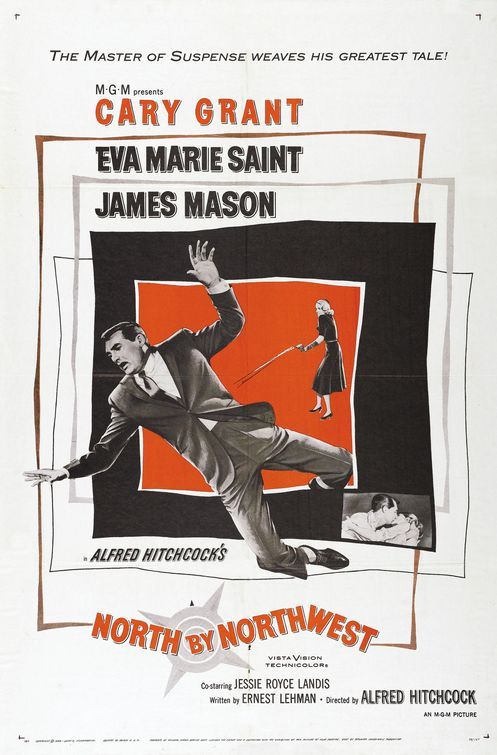
Roger Thornhill se encuentra con la aventura de su vida cuando unos tipos lo confunden de identidad, lo llevan hasta una mansión, le hacen un par de preguntas, cachan que se equivocaron de hombre, lo emborrachan e intentan matarlo. Roger consigue terminar en una estación de policía, pero nadie le cree, porque cuando vuelven al lugar, ¡todos fingen que Roger es una viejo amigo al que se le pasaron las copas no más! Como si eso no fuera suficiente, Roger tiene que escapar de la ciudad, porque los matones quieren terminar lo que no pudieron, y recibe la ayuda de una sospechosa rubia de Hitchcock.
Excelente película, pero la escena final es demasiado mamona. Y me encantaron las actuaciones de James Mason y Martin Landau; todavía no puedo creer que sea Martin Landau, demasiado seco.
#1959#'50#Thriller#Suspenso#Alfred Hitchcock#Cary Grant#Eva Marie Saint#James Mason#Martin Landau#1001 películas#Cine estadounidense
2 notes
·
View notes
Photo

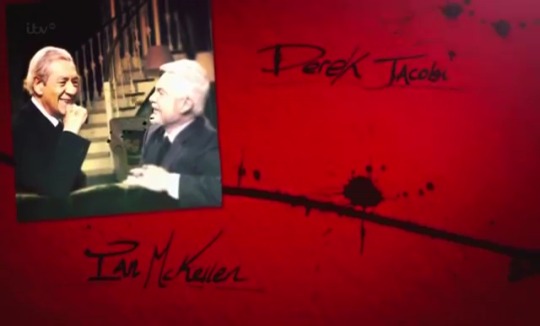

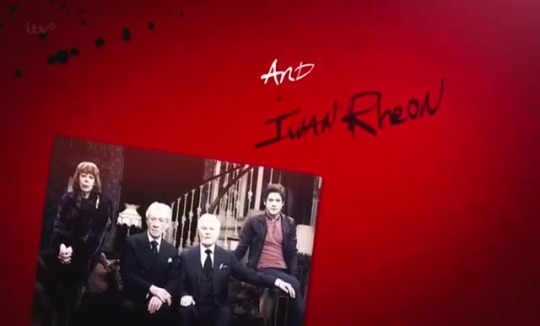


Vicious - ITV - April 29, 2013 - December 16, 2016
Sitcom (14 episodes)
Running Time: 30 minutes
Stars:
Ian McKellen as Freddie Thornhill
Derek Jacobi as Stuart Bixby
Frances de la Tour as Violet Crosby
Iwan Rheon as Ash Weston
Marcia Warren as Penelope
Philip Voss as Mason Thornhill
2 notes
·
View notes
Text
Publicitaire sans histoire, Roger Thornhill se retrouve soudain plongé malgré lui dans une histoire d’espionnage hallucinante qui le mène des rues de New York aux vertigineux sommets du mont Rushmore. Tourné entre Vertigo (Sueurs froides) et Psychose, North by northwest (La Mort aux trousses) est animé par un souffle de légèreté. Le film est à juste titre reconnu comme le plus grand thriller comique d’Hitchcock, qui parvient ici à concilier audace morale et grand succès populaire. Il deviendra un exemple pour la génération suivante des films d’espionnage, James Bond inclus.

NORTH BY NORTHWEST (La Mort aux trousses) – Alfred Hitchcock (1959) – Cary Grant, Eva Marie Saint, James Mason
L’espion malgré lui
Divertissant et moralement osé pour l’époque, North by northwest est un des plus grands succès d’Hitchcock. L’intrigue policière à rebonds, menée avec humour, est écrite, interprétée et réalisée avec le plus grand savoir-faire. Si les scènes d’ivresse ou de séduction, tout comme le regard cynique porté sur les services secrets, deviendront banals dans les années 1960, elles étaient encore audacieuses dans le Hollywood des années 1950. Beaucoup d’éléments de North by northwest se transformeront en clichés ressassés dans les films d’espionnage qui se multiplieront au cours des années 1960 et 1970 : les dialogues humoristiques mêlés à une action violente, l’architecture surréaliste et les scènes fantastiques, le rythme effréné, la figure du patron des services secrets excentrique mais bienveillant, la belle espionne, le truand élégant et son bras droit brutal à la sexualité ambiguë, et, enfin, l’intrigue insensée.
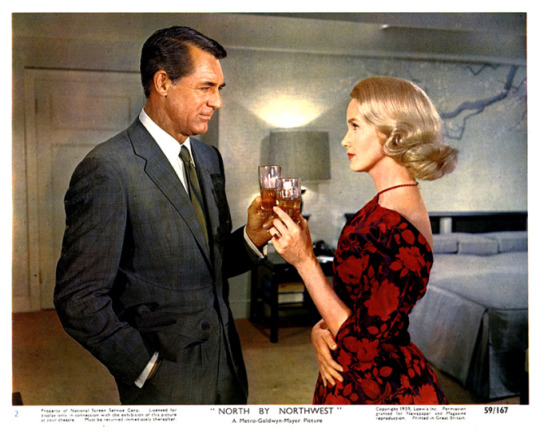
Hitchcock disait à qui voulait l’entendre que North by northwest était une synthèse de tous ses films américains, née d’une gestation beaucoup plus longue que n’importe quelle autre de ses œuvres.
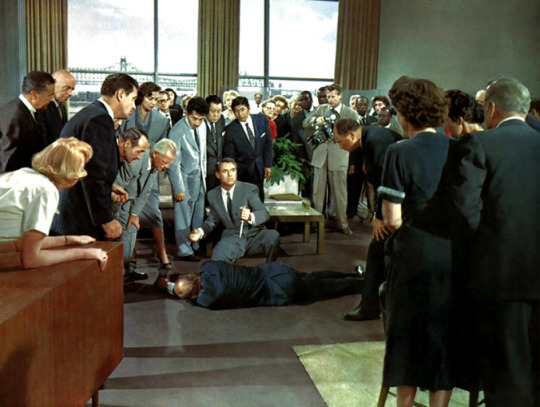
NORTH BY NORTHWEST (La Mort aux trousses) – Alfred Hitchcock (1959) – Cary Grant, Eva Marie Saint, James Mason
La genèse d’un chef-d’œuvre
Vers 1950, Hitchcock commença à penser à la réalisation d’un film qui culminerait dans une scène sur le mont Rushmore, une montagne située dans le Dakota du Sud célèbre pour ses quatre têtes monumentales de présidents américains sculptées à même la roche. Il imaginait alors un héros ressemblant à ses “faux coupables” habituels, grimpant sur les sculptures. Non sans humour, il avait alors baptisé le projet L’Homme dans le nez de Lincoln.

NORTH BY NORTHWEST (La Mort aux trousses) – Alfred Hitchcock (1959) – Cary Grant, Eva Marie Saint, James Mason
En 1952, le journaliste Otis Guernsey lui suggéra l’idée d’un film montrant un américain ordinaire, mais débrouillard, confondu avec un espion et pourchassé à travers tout le pays par une bande d’assassins. L’approche de Guernsey était mièvre et sans originalité ; Hitchcock en retint néanmoins le principe, et l’intégra dans son projet en cours de maturation, au point d’en parler à plusieurs reprises à divers scénaristes tout au long de la décennie.
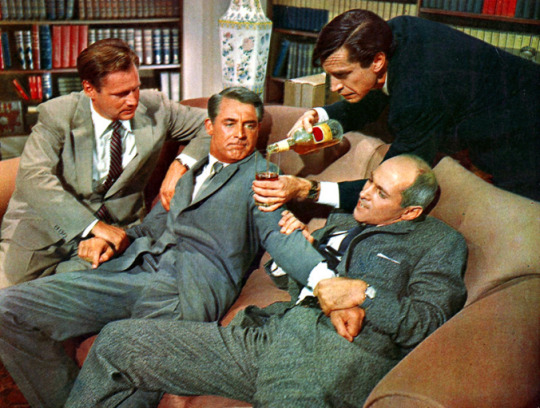
NORTH BY NORTHWEST (La Mort aux trousses) – Alfred Hitchcock (1959) – Cary Grant, Eva Marie Saint, James Mason
Dilemme
Il faudra attendre le tournage de Vertigo pour qu’il trouve enfin le bon collaborateur. Ernest Lehman, un scénariste nominé aux Oscars pour Sabrina (1954) et Sweet smell of success (Le Grand Chantage, 1957), avait accepté de travailler avec lui sur l’adaptation du roman de Hammond Innes The Wreck of the Mary Deare, un vieux projet d’Hitchcock qui présentera trop de difficultés et sera finalement abandonné.

NORTH BY NORTHWEST (La Mort aux trousses) – Alfred Hitchcock (1959) – Cary Grant, Eva Marie Saint, James Mason
Erreur sur la personne
Toutefois, Lehman se montra très intéressé par ce qu’Hitchcock désignait alors comme « une idée provocante qui [l’]obsédait depuis longtemps ». De plus, le scénariste voyait dans l’histoire de L’homme dans le nez de Lincoln l’opportunité de satisfaire une ambition personnelle : écrire un « véritable film animé, [avec] de l’esprit, de la sensualité, de la finesse, du suspense, [et] de nombreux sites hauts en couleur ».
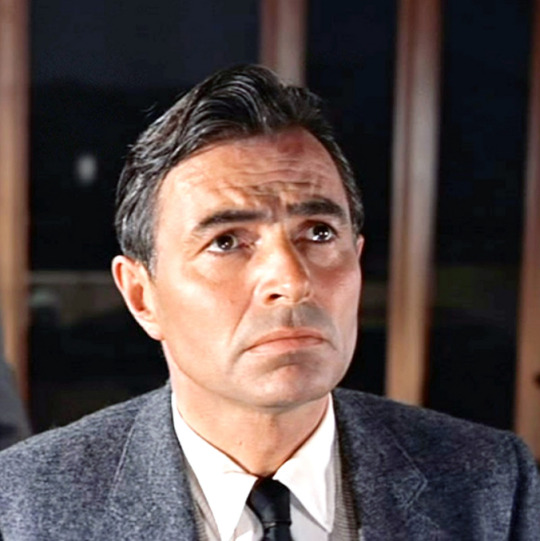
NORTH BY NORTHWEST (La Mort aux trousses) – Alfred Hitchcock (1959) – Cary Grant, Eva Marie Saint, James Mason
D’autres idées vinrent se greffer sur le projet initial : l’homme innocent (appelé Thornhill dès le début) serait confondu avec un homme qui n’existe pas ; un meurtre à l’ONU fut prévu ; l’enchaînement de scènes d’action à travers le pays devait atteindre son point d’orgue lorsque le héros serait suspendu à un nez présidentiel – « une prouesse exceptionnelle », selon Hitchcock.
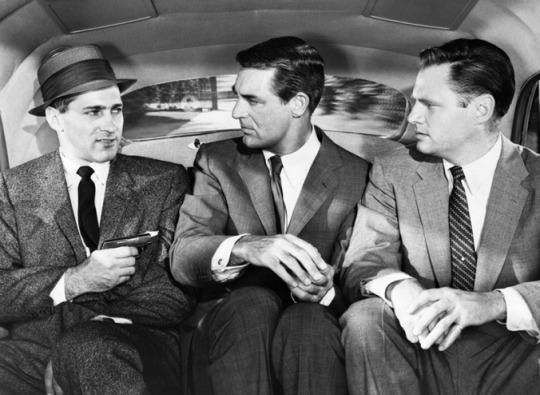
NORTH BY NORTHWEST (La Mort aux trousses) – Alfred Hitchcock (1959) – Cary Grant, Eva Marie Saint, James Mason
Dans le projet de Guernsey, Thornhill était représentant de commerce. Hitchcock et Lehman en firent un cadre de haut vol, grand buveur, travaillant à Madison Avenue, au cœur de l’industrie publicitaire américaine où Lehman avait commencé sa carrière. Le scénariste profitera d’ailleurs du dialogue de la première scène, entre Thornhill et sa secrétaire, pour régler ses comptes avec la publicité.
NORTH BY NORTHWEST (La Mort aux trousses) – AlfrNORTH BY NORTHWEST (La Mort aux trousses) – Alfred Hitchcock (1959) – Cary Grant, EvComme l’administration du parc national pensait que tourner des scènes violentes profanerait ce « sanctuaire de la démocratie », les têtes sculptées du mont Rushmore furent elles aussi entièrement reconstituées en studio.
Comme l’administration du parc national pensait que tourner des scènes violentes profanerait ce « sanctuaire de la démocratie », les têtes sculptées du mont Rushmore furent elles aussi entièrement reconstituées en studio.
Comme l’administration du parc national pensait que tourner des scènes violentes profanerait ce « sanctuaire de la démocratie », les têtes sculptées du mont Rushmore furent elles aussi entièrement reconstituées en studio.
Synopsis
En 1957, Hitchcock apporta un projet de deux pages à la MGM. (Le projet est connu aujourd’hui sous le nom de ln a Northwesterly Direction). Puis, il partit en vacances aux Caraïbes, Après avoir parcouru pendant deux semaines les sites désignés par le réalisateur (Manhattan, Long Island où est située la villa de Townsend, Chicago et le mont Rushmore), Lehman se mit au travail. Au retour d’Hitchcock, en février 1957, 65 pages de scénario étaient achevées.
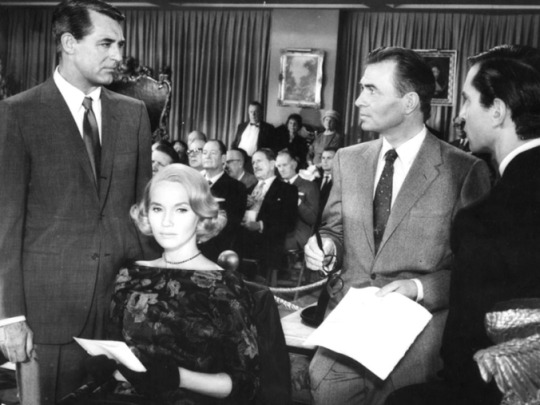
NORTH BY NORTHWEST (La Mort aux trousses) – Alfred Hitchcock (1959) – Cary Grant, Eva Marie Saint, James Mason
Si Hitchcock se montra content du résultat, il fallut toutefois encore plusieurs mois d’échanges et de réécriture avant que Lehman ne fournisse le scénario plein d’esprit et de rebondissements qui donnera au film toute sa saveur.
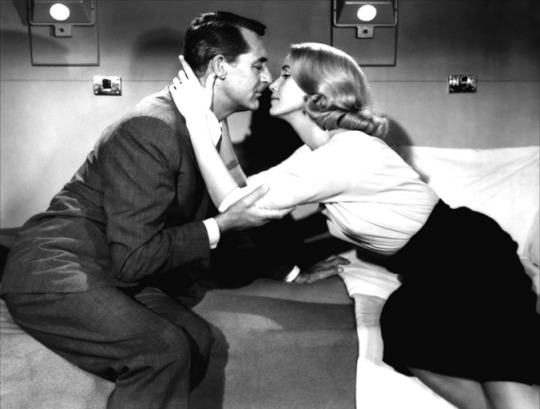
NORTH BY NORTHWEST (La Mort aux trousses) – Alfred Hitchcock (1959) – Cary Grant, Eva Marie Saint, James Mason
Jusque-là, le rôle de Thornhill avait été pensé pour James Stewart, qui, d’ailleurs, y tenait. Hitchcock, lui, attendait. Vertigo n’avait pas obtenu le succès qu’il avait escompté.

NORTH BY NORTHWEST (La Mort aux trousses) – Alfred Hitchcock (1959) – Cary Grant
Cary Grant
L’engagement de James Stewart auprès de la Columbia, en contrepartie de l’engagement de Kim Novak sur Vertigo, permit à Hitchcock d’esquiver le problème avec élégance et d’engager un autre de ses acteurs fidèles, Cary Grant, qui obtint finalement le rôle de Thornhill. Bien qu’âgé de quatre ans de plus que Stewart, Grant pouvait incarner un personnage plus jeune (dans North by northwest, l’actrice qui joue sa mère a onze mois de moins que lui !) et plus séduisant, ce qui ne manquerait pas d’attirer un public féminin et de gonfler les ventes à l’étranger. Cary Grant signa un contrat de 450 000 dollars, assorti d’un pourcentage sur les bénéfices.
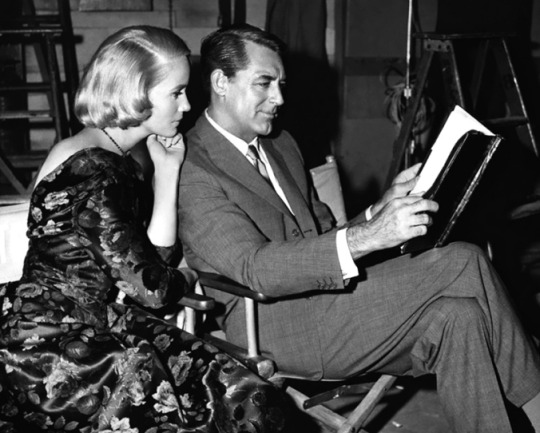
ON SET – NORTH BY NORTHWEST (La Mort aux trousses) – Alfred Hitchcock (1959) – Cary Grant, Eva Marie Saint, James Mason
Les producteurs souhaitaient avoir l’élégante Cyd Charisse pour le rôle féminin, mais Hitchcock lui préféra Eva Marie Saint. L’actrice fut ravie de se mettre entre les mains du maître, qui apporta autant de soin dans le choix de ses toilettes qu’il en avait pris pour l’habillement de Kim Novak dans Vertigo. Il choisit ses vêtements selon l’ambiance de chaque scène, expliquant qu’elle devait être « habillée de couleurs vives pour les ambiances tristes, et vêtue sobrement durant les scènes energiques ».
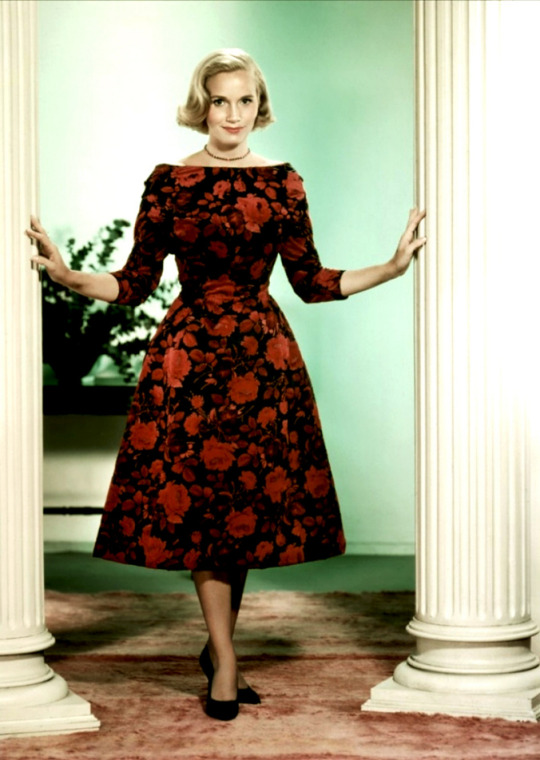
NORTH BY NORTHWEST (La Mort aux trousses) – Alfred Hitchcock (1959) – Eva Marie Saint
Lieux de tournage
Le film devait être tourné en Technicolor par le chef opérateur favori d’Hitchcock, Robert Burks. Ensemble, ils décidèrent d’utiliser le format Vistavision, une technique avec laquelle l’un et l’autre s’étaient familiarisés à la Paramount et qu’ils savaient parfaitement bien utiliser.
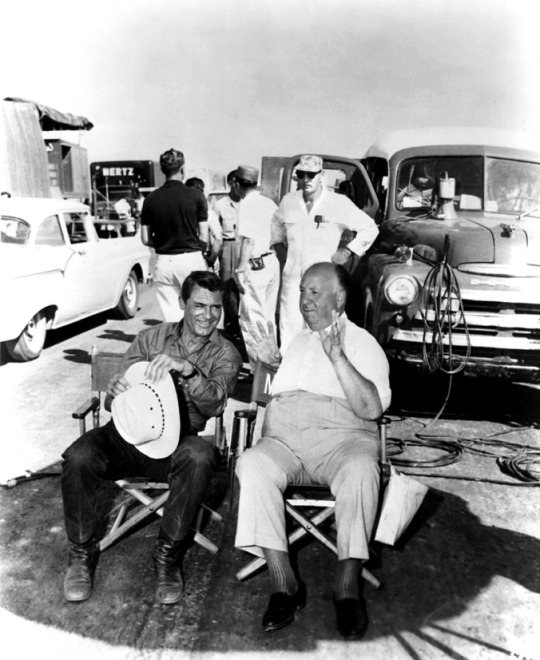
ON SET – NORTH BY NORTHWEST (La Mort aux trousses) – Alfred Hitchcock (1959)
Hitchcock commença officiellement à travailler pour la MGM en juin 1958, et se rendit à New York, Chicago et Rapid City en août. Le premier tournage devait filmer Cary Grant sortant d’un taxi devant le bâtiment de l’ONU. N’ayant pas obtenu l’autorisation de tourner sur les lieux, Hitchcock filma depuis une camionnette garée sur le trottoir d’en face. On remarque d’ailleurs que des passants reconnaissent l’acteur.
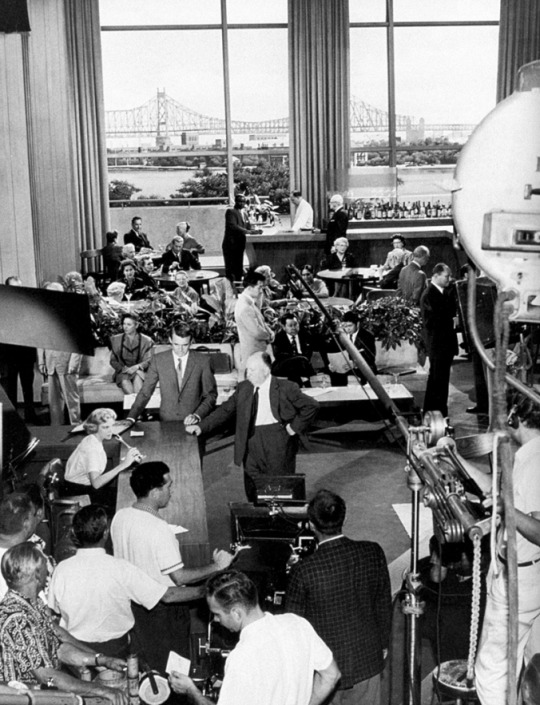
ON SET – NORTH BY NORTHWEST (La Mort aux trousses) – Alfred Hitchcock (1959)
En studio
Bien qu’ayant d’abord obtenu le droit de filmer le mont Rushmore, Hitchcock se vit retirer l’autorisation quand les responsables comprirent qu’il souhaitait tourner une scène de poursuite impliquant des morts, ce qui, selon eux, porterait atteinte au monument. Hitchcock ne resta donc que deux jours à Rapid City, puis il termina le tournage de la scène en studio. Furieuse, l’administration demanda qu’on retire son nom du film. Hitchcock accepta en haussant les épaules…
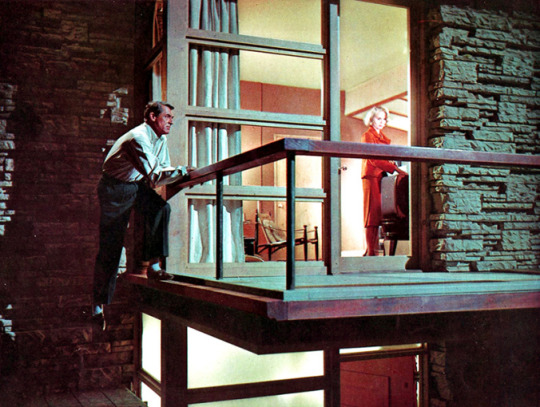
NORTH BY NORTHWEST (La Mort aux trousses) – Alfred Hitchcock (1959) – Cary Grant, Eva Marie Saint, James Mason
En novembre, les scènes de studio étaient terminées. Le montage pouvait commencer. Le budget avait explosé, passant des 3 millions de dollars prévus initialement à 4,3 millions – ce qui n’était pas sans agacer les producteurs de la MGM. En avril 1959, Hitchcock réalisait encore de nouvelles prises.
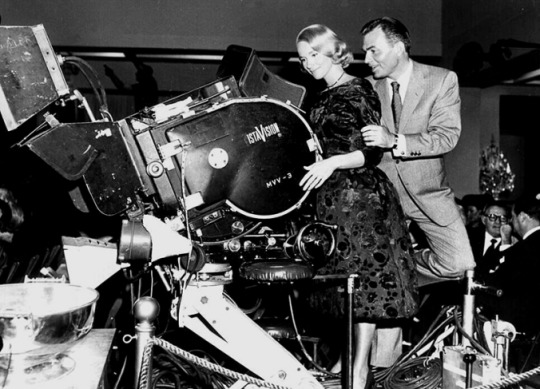
ON SET – NORTH BY NORTHWEST (La Mort aux trousses) – Alfred Hitchcock (1959) – Cary Grant, Eva Marie Saint, James Mason
Indépendance
La MGM jugeait également le film trop long (avec ses deux heures et quart, c’était le plus long d’Hitchcock) et demanda des coupes, notamment la suppression complète de certaines scènes. Mais le contrat laissait au réalisateur un contrôle artistique total sur le film. Hitchcock put ainsi ignorer les appels frénétiques et toujours plus fréquents de la MGM.

ON SET – NORTH BY NORTHWEST (La Mort aux trousses) – Alfred Hitchcock (1959) – Cary Grant, Eva Marie Saint, James Mason
La seule chose qu’il abandonna pour des raisons financières fut un projet de générique montrant Thornhill dans le monde de la publicité. L’idée fut remplacée par l’animation de Saul Bass.

NORTH BY NORTHWEST (La Mort aux trousses) – Alfred Hitchcock (1959) – Cary Grant, Eva Marie Saint, James Mason
Apaiser la censure
Pendant que la postproduction avançait, Hitchcock dut apaiser la susceptibilité de la censure, qui s’intéressait notamment beaucoup à l’homosexualité trop évidente de Leonard et aux relations hors mariage d’Eve et Thornhill.
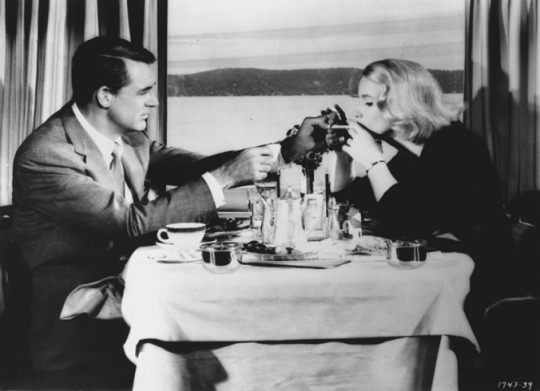
NORTH BY NORTHWEST (La Mort aux trousses) – Alfred Hitchcock (1959) – Cary Grant, Eva Marie Saint, James Mason
Hitchcock fut obligé d’effectuer quelques modifications dans son film. Ainsi, certaines scènes, qui avaient été tournées comme prévu dans le scénario, durent ensuite être doublées avec de nouveaux dialogues, laissant aux seules personnes capables de lire sur les lèvres le plaisir d’avoir accès à la version originale du scénario.

NORTH BY NORTHWEST (La Mort aux trousses) – Alfred Hitchcock (1959) – Cary Grant, Eva Marie Saint, James Mason
Toutefois, le réalisateur ne put s’empêcher d’avoir le dernier mot… La scène finale du film avait été modifiée afin de faire clairement référence à Mme Thornhill, et légitimer ainsi les rapports hors mariage d’Eve Kendall et Roger Thornhill. Mais Hitchcock ajouta ensuite la séquence du train pénétrant dans un tunnel – une scène qui n’avait jamais été soumise à la censure.
https://moncinemaamoiblog.files.wordpress.com/2019/07/01-north-by-northwest-bernard-herr.m4a
BO – North by Northwest / La mort aux trousses (Prélude) – Bernard Hermann
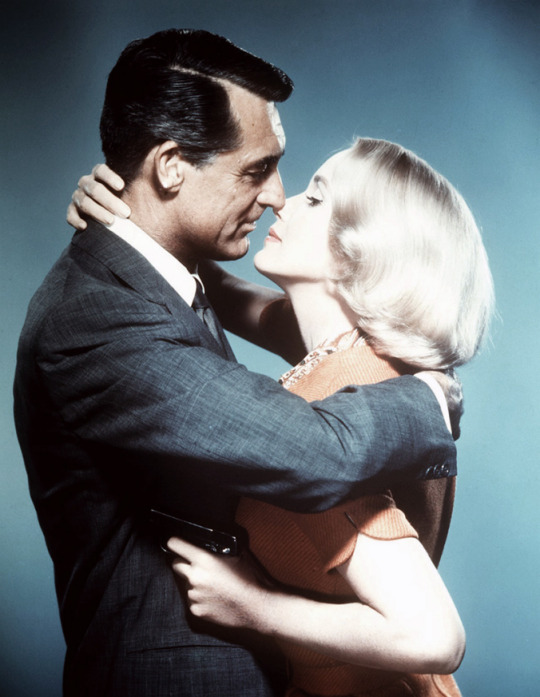
NORTH BY NORTHWEST (La Mort aux trousses) – Alfred Hitchcock (1959) – Cary Grant, Eva Marie Saint, James Mason
Des longueurs ?
En avril 1959, une projection du film entièrement monté renforça les critiques des producteurs, qui estimaient que le film était vraiment trop long. Ils demandèrent des coupures, par exemple la suppression de la scène où Thornhill et Eve se retrouvent dans les bois après la fusillade du restaurant. Hitchcock consulta son avocat, qui l’assura que le contrat ne pouvait être rompu. Le film put donc sortir comme il l’entendait.
Succès
La sortie de North by northwest eut lieu deux mois plus tard, le 1 er juillet 1959, à Chicago. Le film fut apprécié par la critique, et il n’allait pas tarder à devenir un grand succès commercial mondial. Dans un premier temps, sa seule diffusion en Amérique du Nord entraîna déjà des bénéfices, et il atteignit rapidement le sommet du box-office de l’année.

NORTH BY NORTHWEST (La Mort aux trousses) – Alfred Hitchcock (1959) – Cary Grant, Eva Marie Saint, James Mason
North by northwest fut nominé trois fois aux Oscars : meilleur scénario (Ernest Lehman), meilleure direction artistique (Robert Boyle, William Horning, Merrill Pye, Henry Grace, Franck McElvy) et meilleur montage (George Tomasini). Mais il n’en obtint aucun !
L’histoire
Kidnapping
L’arrière-plan en treillis du générique se transforme progressivement en un immeuble new-yorkais et laisse place à un enchaînement de scènes de rue. Roger Thornhill, un publicitaire, dicte ses messages à sa secrétaire tout en prenant un taxi pour se rendre à une réunion à l’hôtel Plaza. Là, deux gorilles le prennent pour un certain George Kaplan et le kidnappent sous la menace d’une arme.
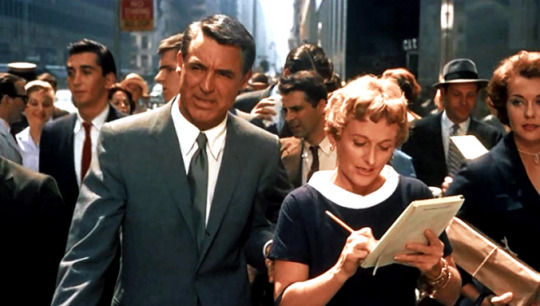
Mr Townsend
Thornhill est emmené dans une villa sur Long Island, où il est interrogé par un certain Townsend. On lui fait avaler une bouteille de whisky, puis un des gorilles l’installe au volant d’une voiture sur une route côtière sinueuse. L’ayant éjecté par la portière de la Mercedes volée, Thornhill, ivre mort, parvient à se maintenir sur la route en zigzaguant, avant qu’une voiture de police ne vienne s’encastrer dans la sienne.
Ivresse à charge
Dans le commissariat, Grant se livre à une scène d’ivresse des plus hilarantes. À son procès, sa mère ajoute encore à l’humour. L’enquête de la police ne trouve rien pouvant étayer la version des faits de Thornhill sur ce qui s’est passé dans la villa. Sa mère et lui se rendent à l’hôtel Plaza, à la recherche de George Kaplan. Pour 50 dollars, Mme Thornhill accepte de demander la clé de la chambre de Kaplan, où son fils découvre une photo du prétendu Townsend.

L’insaisissable Mr Kaplan
Roger Thornhill interroge la femme de chambre et le garçon d’étage. Personne n’a réellement vu Kaplan – dont les costumes sont visiblement bien trop petits pour Thornhill. Les deux malfaiteurs retrouvent les Thornhill dans un ascenseur bondé où Mme Thornhill tente de détendre l’atmosphère en plaisantant. Roger Thornhill parvient à s’échapper en utilisant avec brio la foule et la galanterie. Il saute dans un taxi et va à l’ONU. Pour la première fois, il utilise le nom de George Kaplan.
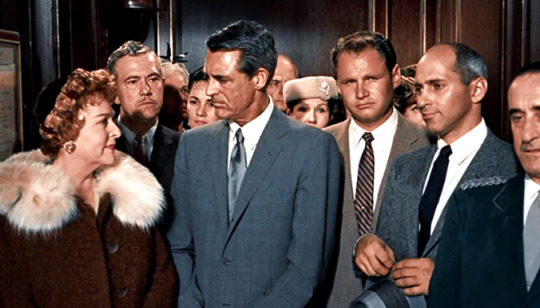
Un mort à l’ONU
L’homme qui a interrogé Thornhill dans la villa n’était pas Lester Townsend : celui-ci se fait tuer d’un coup de poignard dans le dos. Soupçonné du meurtre, Thornhill s’enfuit. Une scène dans les bureaux de la CIA, où trône un énigmatique personnage appelé Professeur, nous révèle que Kaplan est un personnage fictif. Le fait qu’il soit confondu avec Thornhill arrange les agents secrets, qui sont prêts à sacrifier sa vie pour mettre la main sur le truand Philip Vandamm. Thornhill, déclaré fugitif, se faufile jusqu’au train en partance pour Chicago.
Couchette cachette
Dans le train, Thornhill échappe aux contrôleurs grâce à une jeune femme blonde. Plus tard, dans le wagon-restaurant, il se retrouve assis en face d’elle. Elle lui avoue avoir arrangé cette situation et se présente sous le nom de Eve Kendall. Lui dit s’appeler Jack Phillips, mais elle connaît son vrai nom. Un flirt commence : elle l’invite dans sa cabine, une proposition particulièrement franche pour l’époque ! Quand la police monte dans le train à la recherche de Kaplan, c’est dans sa couchette murale qu’il se cache.

La valse des uniformes
Thornhill s’est confié à Eve au sujet de l’identité de Kaplan. Seuls dans la minuscule cabine, ils s’embrassent, s’étreignent et roulent le long des murs, ce qui suggère, sans la montrer, une scène d’amour. Eve remet un message à l’employé des wagons-lits, qui le transmet à Vandamm et Leonard, eux aussi présents dans le train. À Chicago, Thornhill descend du train avec Eve, portant ses bagages et vêtu d’un uniforme de porteur. Eve va téléphoner à Kaplan. La découverte d’un porteur dépouillé de son uniforme donne lieu à une valse de policiers se jetant sur tous les porteurs à travers la gare.

Extérieur
Dans une scène pleine d’humour, Thornhill, toujours recherché par la police, se cache derrière un masque de mousse à raser. Eve est toujours en train de téléphoner ; on comprend qu’elle parle à Leonard et non à Kaplan. Elle indique ensuite à Thornhill que George Kaplan le rencontrera à un arrêt de car en dehors de la ville. Sur place, Thornhill ne voit rien d’autre que quelques voitures passant rapidement et un avion bas sur l’horizon. Arrivé en voiture, un fermier blasé lui dit attendre le car dans le sens opposé. Juste avant de partir, il note que l’avion déverse de l’insecticide à un endroit où il n’y a pas de plantations.
Un ciel bleu et limpide
L’avion attaque Thornhill, qui se cache dans un champ de maïs. Ensuite, Thornhill arrête un camion-citerne dans lequel vient s’encastrer l’avion. Au cœur de la confusion qui s’ensuit, Thornhill vole un pick-up et fonce vers Chicago. Toute la séquence dans les champs est filmée avec un minimum de dialogues, un bruitage naturel et sans aucune musique.
À la recherche de Kaplan, Thornhill se rend à sa dernière adresse. Là, il découvre qu’il est parti avant l’heure à laquelle Eve affirme lui avoir parlé. Thornhill comprend qu’il a été trahi. Il aperçoit Eve dans le hall de l’hôtel et la suit dans sa chambre, où elle semble surprise, mais sincèrement heureuse de le voir.
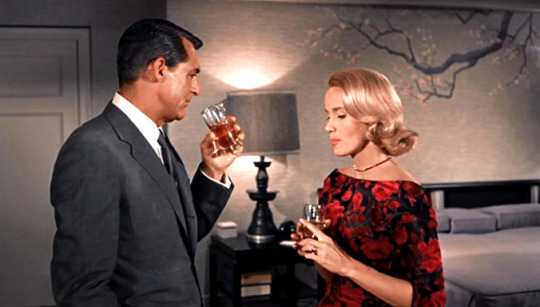
Double déception
Le gros titre d’un journal annonce deux morts dans l’accident d’avion. On ignore qui sont ces deux morts, mais l’un des agresseurs du début ne réapparaîtra plus. Eve et Thornhill s’opposent : il veut la garder près de lui, elle souhaite s’en débarrasser. En définitive, Thornhill lui joue un tour et la suit jusqu’à une salle de ventes aux enchères, où il la retrouve en compagnie de Vandamm et Leonard.
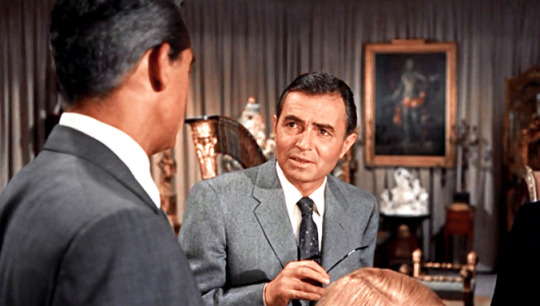
La salle des ventes
Il les accoste et menace de se rendre au commissariat, mais les issues sont bloquées par les hommes de Vandamm. Dans une scène qui évoque le meeting politique des Trente-Neuf Marches, Thornhill échappe à ses agresseurs en simulant l’ivresse et en enchérissant d’une manière totalement irrationnelle. Arrêté, il se présente comme l’assassin de l’ONU aux agents qui le conduisent au commissariat. Mais au lieu de l’arrêter, les policiers reçoivent l’ordre de le déposer à l’aéroport.
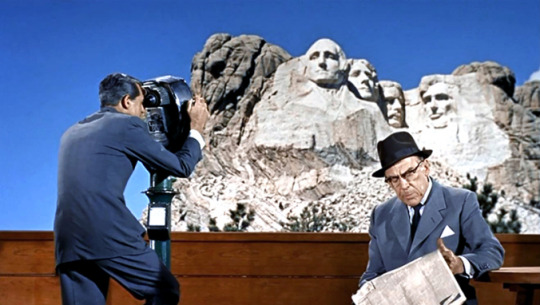
Présidents morts
Le Professeur, qui se trouvait à la vente, lui annonce qu’ils vont à Rapid City, où vit Vandamm. Thornhill accepte de coopérer avec lui seulement après avoir appris qu’Eve est un agent double et que sa vie est en danger. Vandamm, Leonard et Eve rencontrent Thornhill dans le restaurant proche du mont Rushmore. La discussion tourne mal, et Eve tire sur Thornhill avec un revolver. Thornhill s’en sort indemne et retrouve Eve. Il apprend qu’elle doit partir le soir même avec Vandamm.
Microfilm
Thornhill est détenu à l’hôpital. La radio annonce que Kaplan a été grièvement blessé dans une fusillade. Sachant qu’Eve part durant la nuit, Thornhill s’échappe et se rend en taxi devant la maison futuriste de Vandamm, au sommet du mont Rushmore. Là, il peut épier Vandamm. Leonard demande un tête-à-tête à Vandamm avant son départ. Sans entendre toute la conversation, on apprend qu’un microfilm est caché dans une statuette achetée à la salle des ventes. Thornhill voit avec horreur Leonard apprendre à Vandamm qu’Eve l’a trompé. Vandamm décide de se débarrasser d’elle au-dessus de l’océan – la sensation de menace est accentuée par les mouvements de caméra.

Au sommet
Thornhill grimpe jusqu’à la chambre d’Eve pour l’avertir, mais la jeune femme sort de la pièce au moment où il arrive. Il jette alors un mot écrit sur une boîte d’allumettes à ses initiales. Ils se voient brièvement. Eve suit Vandamm pour récupérer la statuette. Thornhill est arrêté par la gouvernante, qui le menace avec une arme. Vandamm emmène Eve jusqu’à l’avion. Des coups de feu éclatent. Quand Thornhill arrive enfin, Eve saisit la statuette. Les portes du jardin étant fermées, ils doivent fuir à pied et se retrouvent au sommet du monument.
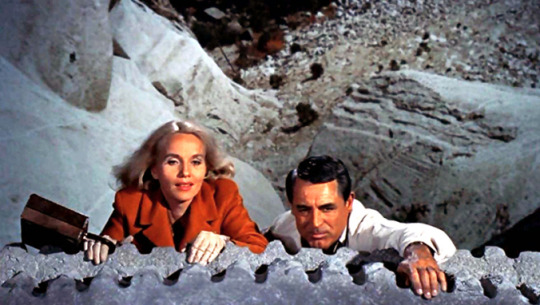
La fuite
Poursuivis par Leonard et son aide, ils commencent à descendre sur les visages monumentaux. l’aide est précipité vers la mort depuis le menton de Washington. Leonard s’empare de la statuette et pousse Eve, qui est retenue de justesse au-dessus du vide par Thornhill. Leonard tente de lui faire lâcher prise en lui écrasant la main, quand un coup de feu le précipite à son tour dans le vide, brisant la figurine. Au loin, on voit Vandamm arrêté, qui déclare : « Pas très élégant d’utiliser de vraies balles… »
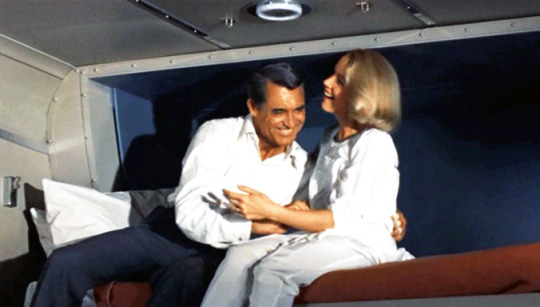
Un dernier message
La dernière minute du film est composée de deux séquences typiquement hitchcockiennes. D’abord, la transition entre Thornhill tentant de hisser Eve sur la falaise et la même Eve tirée dans la couchette du train qui ramène les deux amants, mariés, vers la côte Est. Cette ellipse boucle l’histoire d’amour (le film repose sur le très classique schéma hollywoodien en trois actes : un homme rencontre une femme, il la perd, puis la retrouve). Ensuite, la séquence finale du train pénétrant dans un tunnel, probablement ajoutée par Hitchcock pour réagir à la censure qui n’avait cessé de le gêner durant tout le tournage.
Fiche technique du film
Publicitaire sans histoire, Roger Thornhill se retrouve soudain plongé malgré lui dans une histoire d'espionnage hallucinante qui le mène des rues de New York aux vertigineux sommets du mont Rushmore. Tourné entre Vertigo (Sueurs froides) et Psychose, North by northwest (La Mort aux trousses) est animé par un souffle de légèreté. Le film est à juste titre reconnu comme le plus grand thriller comique d'Hitchcock, qui parvient ici à concilier audace morale et grand succès populaire. Il deviendra un exemple pour la génération suivante des films d'espionnage, James Bond inclus. Publicitaire sans histoire, Roger Thornhill se retrouve soudain plongé malgré lui dans une histoire d'espionnage hallucinante qui le mène des rues de New York aux vertigineux sommets du mont Rushmore.
10 notes
·
View notes
Photo
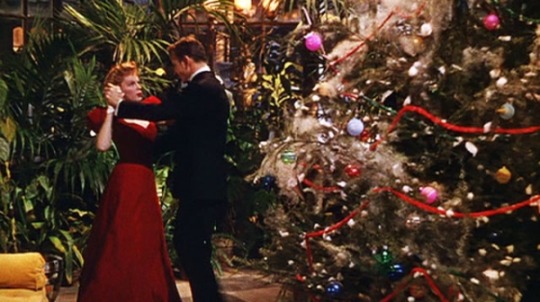
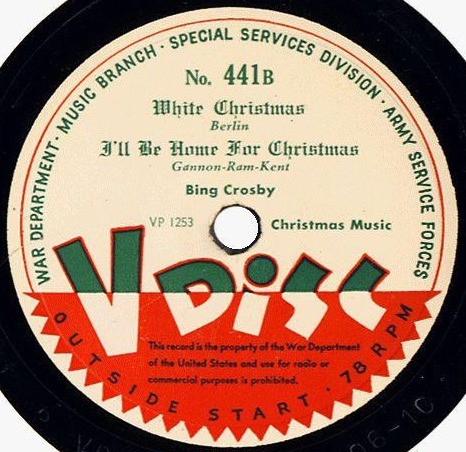

Chart-Topping Christmas Singles — 1920-1945
Popular Christmas themed songs aren’t a new thing — they saw their infancy in the 1930s, and by the 1940s many popular seasonal songs from films and by popular artists were making the charts. These popular Christmas songs tended to be about not only Christmas, but also wintertime and the season in general and did not typically have overtly religious themes (a change from the carols of the pre-1930s).
Below is a list of chart-topping Christmas singles that would have been radio favorites between 1920 and 1945. Many of those released during WWII would be also been release on V-Disc to US military personnel, so it is highly likely they would be familiar to our boys while they were overseas.
Auld Lang Syne - Peerless Quartet | 1921
Reached No. 5 on the Pop charts.
Written by Robert Burns.
Guy Lombardo and His Royal Canadians first performed the song on radio in 1929, then recorded it in 1939.
Parade of the Wooden Soldiers - Vincent Lopez Orchestra | 1922
The Vincent Lopez Orchestra version peaked at No. 3 on the pop singles chart.
Other charted versions include Carl Fenton's Orchestra (1922), and Paul Whiteman and His Orchestra (1923).
Music written in 1897 by Leon Jessel and popularized by Nikita Balieff's 1920s musical revue La Chauve-Souris.
Adeste Fideles (O Come, All Ye Faithful) - Associated Glee Clubs of America | 1925
Peaked at No. 5 on the pop singles chart.
Santa Claus Is Comin' to Town - George Hall and the Hotel Taft Orchestra
| 1934
Written in 1933 by Haven Gillespie and J. Fred Coots.
Other notable hit versions were by Bing Crosby and The Andrews Sisters (1943)
Winter Wonderland - Guy Lombardo and His Royal Canadians | 1934
Lombardo's version peaked at No. 2 on the pop singles chart.
A version by Ted Weems and his Orchestra peaked at No. 13 on the pop singles chart.
Written in 1934 by Felix Bernard (composer) and Richard B. Smith (lyricist).
Jingle Bells - Benny Goodman and his Orchestra | 1935
B-Side was Santa Claus Is Comin' To Town by the Tommy Dorsey Orchestra.
A version was released in 1941 with by Glenn Miller and his Orchestra, featuring vocals by Tex Beneke, Ernie Caceres and The Modernaires.
Other hit versions recorded by Bing Crosby and The Andrews Sisters (1943)
Silent Night - Bing Crosby | 1935
Written on Christmas Eve in 1818 in Germany by Franz Gruber under the title "Stille Nacht, heilige Nacht".
Crosby's hit version features the Victor Young Orchestra and backing vocals by the Guardsmen Quartet.
First known recorded version in the U.S. was by Paul Whiteman and His Orchestra in 1928.
What Will Santa Claus Say (When He Finds Everybody Swingin'?) - Louis Prima and his New Orleans Gang | 1936
The Little Boy that Santa Claus Forgot - by Vera Lynn | 1937
(Don't Wait 'Till) The Night Before Christmas - Eddy Duchin and his Orchestra | 1938
Featuring vocals by Stanley Worth. Peaked at No. 9 on the pop singles chart.
Babes in Toyland/March of the Toys - Tommy Dorsey Orchestra | 1939
Written by Victor Herbert and Glen MacDonough.
Hello, Mr. Kringle - Kay Kyser and his Orchestra | 1939
Novelty record with Ginny Simms, Ish Kabibble, Sully Mason & Harry Babbitt on vocals.
The Night Before Christmas - Milton Cross | 1939
Recitation of Clement Moore's famous 1823 poem "A Visit from St. Nicholas" with musical background orchestrated by Victor Salon.
When Winter Comes - Artie Shaw & his Orchestra | 1939
Peaked at No. 6 on the pop singles chart.
Featuring vocals by Tony Pastor.
From the 1939 film Second Fiddle.
Snowfall - Claude Thornhill and His Orchestra | 1941
Written by Claude Thornhill.
Winter Weather - Benny Goodman | 1941
Peaked at No. 24 on the pop singles chart.
Featuring Peggy Lee and Art Lund on vocals.
Also recorded in 1941 by Fats Waller.
Happy Holiday - Bing Crosby | 1942
Written by Irving Berlin for the 1942 film Holiday Inn, co-starring Crosby and Fred Astaire.
Hit versions were recorded by Peggy Lee, Andy Williams, and Steve Lawrence & Eydie Gorme.
White Christmas - Bing Crosby | 1942
Spent eleven weeks at No. 1 on Billboard's National Best Selling Retail Records chart and three weeks at No. 1 on Billboard's Harlem Hit Parade chart in late 1942.
Written by Irving Berlin.
This version featured the Ken Darby Singers and John Scott Trotter's Orchestra.
The song debuted in the 1942 film Holiday Inn (sung by Crosby).
Other charting recordings by Gordon Jenkins (1942), Charlie Spivak (1942), Frank Sinatra (1944), Freddy Martin (1945)
I'll Be Home for Christmas - Bing Crosby | 1943
Written during World War II by Kim Gannon, Walter Kent and Buck Ram to honor soldiers overseas.
Let's Start the New Year Right - Bing Crosby | 1943
With the Bob Crosby orchestra.
From the 1942 film Holiday Inn.
Have Yourself a Merry Little Christmas - Judy Garland | 1944
Peaked at No. 27 on the pop singles chart.
Featuring orchestration by Georgie Stoll.
Written by Ralph Blane and Hugh Martin
Introduced in the 1944 film Meet Me in St. Louis starring Garland.
The Bells of St. Mary's - Bing Crosby | 1945
Written by A. Emmett Adams and Douglas Furber in 1917.
While the song has no lyrical relation to Christmas, its inclusion in the 1945 film of the same name has made it a popular choice for various artists' holiday albums.
Christmas Carols by the Old Corral - by Tex Ritter | 1945
Peaked at No. 2 on Billboard's Most-Played Juke Box Folk Records chart.
Let It Snow! Let It Snow! Let It Snow! - Vaughn Monroe | 1945
Written by Sammy Cahn and Jule Styne.
Image Sources
Judy Garland and Tom Drake in 1944′s “Meet Me in St. Louis” | Source
“White Christmas” and “I’ll be home for Christmas” V-Disc | Source
“Sant Claus is Coming to Town” | Source
[ Support SRNY on Patreon! ]
#Steve Rogers#christmas#Christmas songs#Christmas music#Christmas carols#1920s#1930s#1940s#seasonal#festive#Bing Crosby#early 20th century#captain america#Captain America: The First Avenger#CAPTAIN AMERICA REFERENCE#Captain America: TFA#fanfiction#fanfic#Fanfic references#fanfic research#research#reference#fan fic writing#V-disc#bucky#Bucky Barnes#james bucky barnes#historically accurate#1920s music#1930s music
67 notes
·
View notes
Photo

Five Cary Grant Films To Watch Right Now by Jill Blake
FilmStruck has given us definitive proof that the number 13 isn’t an unlucky one, as there are 13 movies to choose from the one and only Cary Grant. You really can’t go wrong with any of these films, from the bizarre SYLVIA SCARLETT (’35), ARSENIC AND OLD LACE (’44) and THE BACHELOR AND THE BOBBY-SOXER (’47). If you’re like me, you’ll take Grant however you can get him. But if you’re unsure where to start, I’ve selected five films that I think deserve a look.
Keep Calm and Cary on!
GUNGA DIN (’39)—Directed by George Stevens and starring Cary Grant, Douglas Fairbanks Jr. and Victor McLaglen
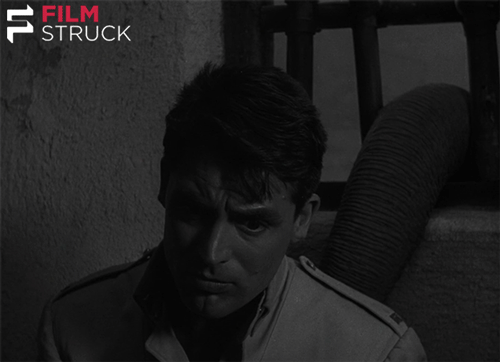
GUNGA DIN is just a really fun movie and one of the greatest action-adventures ever made. It also greatly influenced the action-adventure genre and inspired many films that came along years later, such as the Indiana Jones
series. And then there’s just the sheer ambition of the project, headed up by director George Stevens. It was the biggest production RKO had produced and the largest location shoot for Hollywood at the time, with 1500 extras out in the Lone Pine desert. This is also a really unique role for Grant. He made very few action-adventure films, but he made two of them in 1939: GUNGA DIN and ONLY ANGELS HAVE WINGS. In GUNGA DIN, we get a rare glimpse at a different Grant persona – Sgt. Cutter is carefree, childlike and a prankster. He’s a rascal. And Grant perhaps injected some of his real self in the character, with the Cockney accent and even the use of his birth name, Archibald. The character of Sgt. Cutter is free to seek adventure with his close male friends without any romantic entanglements for himself. Cary Grant without a romantic interest? Strange, isn’t it? But it works so well here. GUNGA DIN is truly a rare gem in Grant’s filmography and proves that he had great versatility as a performer. With the right story and direction, Grant would’ve been a great action/adventure star or perhaps even in Westerns.
MY FAVORITE WIFE (’40)—Directed by Garson Kanin and starring Cary Grant, Irene Dunne, Gail Patrick and Randolph Scott
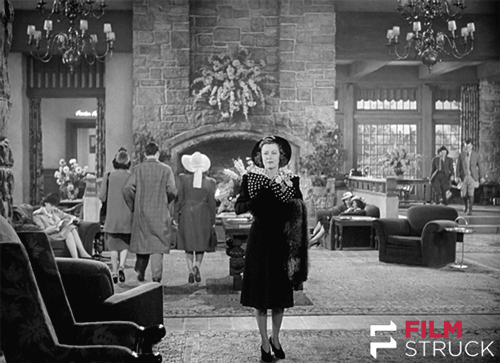
Like many screwball comedies, MY FAVORITE WIFE is a comedy of remarriage – and in this case, bigamy. Grant’s Nick Arden is a widower with two children. His wife, Ellen, played by Irene Dunne, has been missing for 7 years after her ship sinks. She is declared dead, but on the day of his marriage to his second wife (Gail Patrick) Ellen returns. Screwball comedy ensues. Grant was perfect for screwball because he didn’t take himself seriously. He wasn’t afraid to make himself look foolish. He had an air of sophistication with his attractive looks and his bespoke suits, and he maintains the illusion that he has everything in control, but in reality he’s this close to descending into chaos. All it takes is the slightest interruption in his routine—just a feather touch that knocks him completely over. Grant also had an impeccable sense of timing, especially when it came to the physicality required for comedy. This skill was learned during his days as an acrobat.
DESTINATION TOKYO (’43)—Directed by Delmer Daves and starring Cary Grant and John Garfield
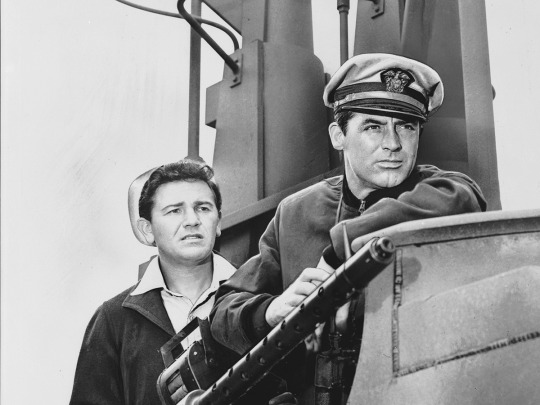
First of all, DESTINATION TOKYO is very problematic in spots, particularly in its depiction of the Japanese—unfortunately common in film during WWII. But it’s also an important and interesting time capsule of what was happening at the time, the attitudes and concerns of Americans. And ultimately, it’s a just a great, compelling story. There is depth to the characters and we care about them. In this film, we see the understated, stoic aspect of Grant’s star persona that he has in ONLY ANGELS HAVE WINGS, except there’s no romantic interest. There’s no tuxedo or ascot. He’s playing a regular guy—albeit an exceptional one—one who is a respected leader. But he’s relatable. He’s the son, brother, husband, father who is off fighting the war. He keeps cool under pressure and he gives audiences hope that their loved ones will return home, too.
MR. BLANDINGS BUILDS HIS DREAM HOUSE (’48)—Directed by H.C. Potter and starring Cary Grant, Myrna Loy and Melvyn Douglas
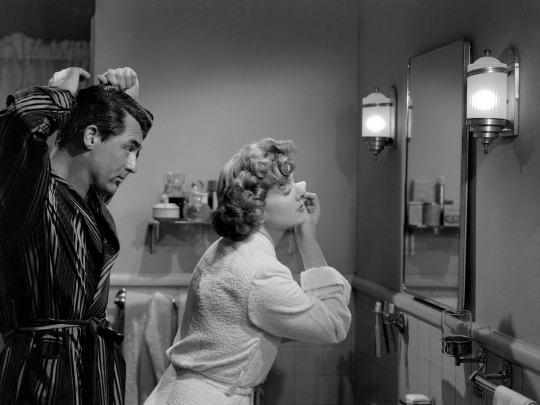
In post-War America, priorities shifted as families wanted more comfort and stability but also concerned themselves with what their neighbors had. Grant is in a loving, stable marriage, one that is far removed from the newlywed stage. He is in his career job with a solid, respectable salary, two children and a loving wife. But it’s not enough. It’s time to move to the next step. And he realizes that he and his family can move to that next step—one of comfort—and that’s exciting. But for all the comforts of this new life comes its own set of problems. Overspending, juggling of career and family; needing to work more to have more but struggling to enjoy what you’ve earned because you have to keep working. So, finding the balance is part of the journey. Grant was paired with many different leading ladies, and with perhaps one or two exceptions, they all work together beautifully. Grant made three films with the great Myrna Loy: the rarely seen WINGS IN THE DARK (’35), THE BACHELOR AND THE BOBBY-SOXER and BLANDINGS. Loy had a knack for matching Grant at every turn without being mean spirited in her challenges or threatening. There’s a real naturalness to their chemistry, one that feels familiar and lived-in. It’s a more mature relationship. It’s not lustful or passionate, like some of Grant’s other romantic roles, but it’s no less loving. Grant demonstrates that he can play both charming lothario and loving husband and family man with equal romanticism.
NORTH BY NORTHWEST (’59)—Directed by Alfred Hitchcock and starring Cary Grant, Eva Marie Saint and James Mason
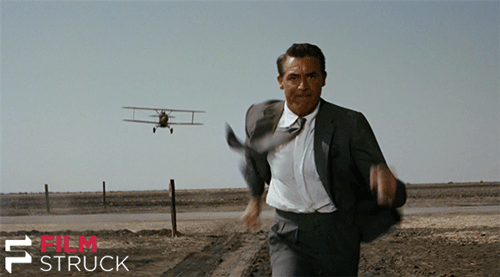
This film marks the end of a successful four-film collaboration between Grant and Hitchcock. Unlike other Hitchcock collaborators, like James Stewart who also made four films with the master of suspense, Grant gets a good ending. We’re first introduced to him in SUSPICION (’41) as a possible murderer. Then in NOTORIOUS (’46), he’s a brooding, self-loathing, woman-hating mysterious figure. In TO CATCH A THIEF (’55), we see a glimpse of what Roger Thornhill becomes in his reformed jewel thief John Robie, but there’s still an element of danger and intrigue. In NORTH BY NORTHWEST, Hitchcock pulls elements from all of these performances into something that is funny, complex, dark and dangerous. Grant’s Roger Thornhill becomes an unlikely, reluctant hero. And that’s a great send-off.
#FilmStruck#Cary Grant#Gunga Din#Destination Tokyo#My Favorite Wife#Mr. Blandings Builds His Dream Home#North By Northwest#Alfred Hitchcock#StreamLine Blog#Jill Blake
95 notes
·
View notes